How To Sell An Ebook On Your Blog
Based on my own experience learning how to write an eBook (and selling those eBooks) both here on my own blog for the past 10+ years to an audience of 500,000 monthly readers—and as a hired consultant for brands like Adobe, Zendesk, Gusto & Close… this is my ultimate guide about how to write an eBook (and successfully sell it) today.
How to Write an eBook (and Sell 1,328+ Copies) in 2022
- Choose a Smart eBook Idea to Write About
- Develop the Outline (and Structure) of Your eBook
- Map Out the Ideal Length and Start Writing Your eBook
- Pick the Right File Format for Your eBook
- Design an Eye-Catching eBook Layout and Cover
- Sell Your eBook to Your Existing Audience
- Expand Your Reach by Selling Your eBook on Amazon
Disclosure: Please note that some of the links below are affiliate links and at no additional cost to you, I'll earn a commission. Know that I only recommend products and services I've personally used and stand behind. When you use one of my affiliate links, the company compensates me, which helps me run this blog and keep all of my in-depth content free of charge for readers (like you).
Since writing one of my most popular eBooks to-date, The Habits of Highly Successful Bloggers, I've sold more than 1,328 copies to my audience alone.
That's translated into a total of $9,296 in revenue for my blog business—all from a single asset that I slowly wrote over the course of just a couple weeks on the side of my day job a few years ago. Here's a screenshot of the sales figures since the first version of this eBook came out toward the end of 2016:
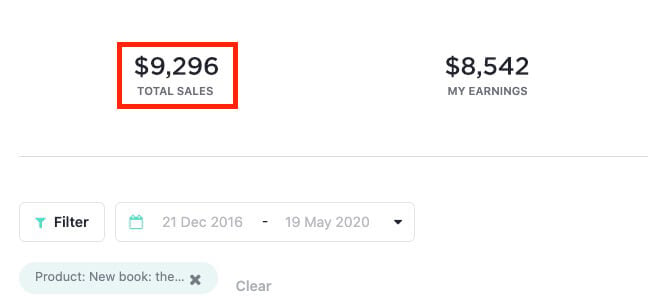
Want to know the best part about writing and selling eBooks?
You don't even need a large audience to start generating a meaningful amount of sales—as long as your eBook truly solves a clear need in a niche with proven demand.
Whether you've started a blog of your own or not… you can generate a substantial amount of income by selling eBooks on a social media platform where your target audience spends a lot of time.
Take for example the former Amazon AWS developer, Daniel Vassallo, who only recently left his day job to start teaching the many lessons he's learned as a developer (and now self-taught marketer) throughout his career. He's sold well over $150,000+ in eBooks almost entirely on Twitter, and is starting to expand into video courses:
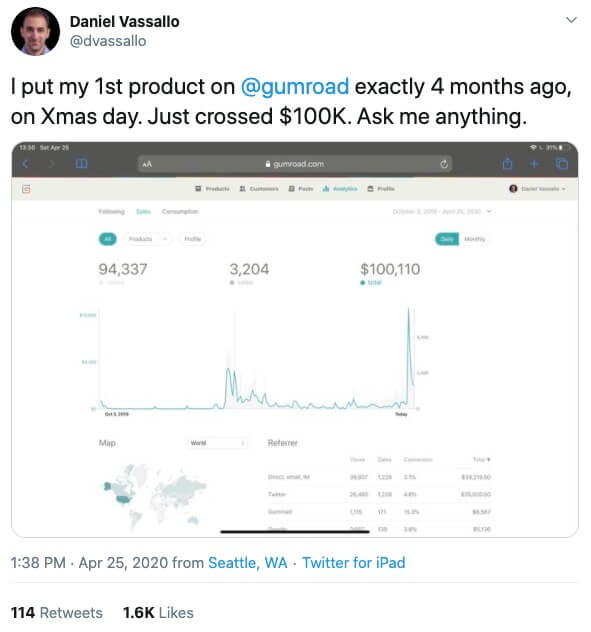
If Twitter (or social media in general) isn't your thing, no worries…
One of my blog readers, Raza Imam, has built a $5,000/mo passive side business where he writes eBooks and sells them only on Amazon. Here's a snapshot of one of his first eBooks ranking as the #1 bestseller in the general Men's Health category—out of all related books on Amazon at the time:
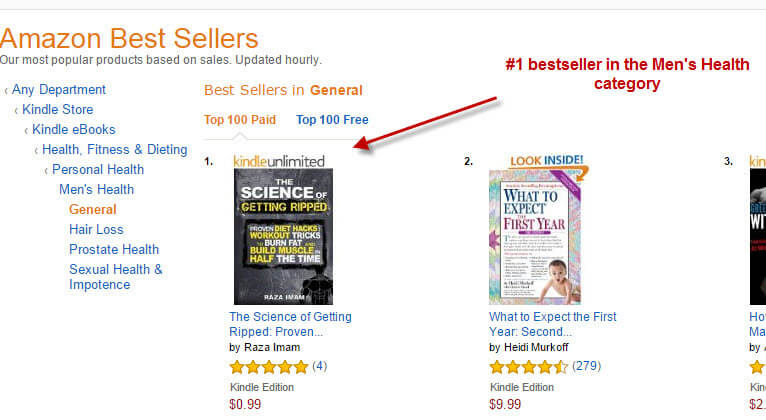
Several of his eBooks have become #1 bestsellers within their niche categories on Amazon as a result of investing time into perfecting his listings (and writing a genuinely useful book)—two topics we'll be talking a lot about here in this guide. However, all of this is to say…
You don't need a massive audience in order to write an eBook (and successfully sell it).
First before we dive into this guide, I wanted to answer a few of the most frequently asked eBook-related questions I field from my readers (click to expand each question and see my answers).
Why should I write an eBook (as a blogger)?
Many bloggers take the next step from writing blog posts to writing their own eBooks. It's a natural progression for bloggers in particular, because we're already used to writing a lot of content.
Plus, after spending time cultivating and learning from your growing audience (no matter the size), you start to understand what people want—and what kinds of topics might work well for an eBook. There are a lot of very compelling reasons for bloggers to learn how to write an eBook early on in their journey, including:
- eBooks help you attract visitors to your blog and establish authority: A massive benefit to writing an eBook, is that it can attract new people to your blog—and it helps establish yourself as an authority within your blog niche. Even if you're already writing long-form content, an eBook gives the impression that you've taken your blog to the next level. It's a higher value asset than a public blog post, and thus gives a sense of accomplishment and expertise to your readers.
- Your eBooks can help further educate readers: An eBook allows you to take an idea that might interest your audience and give you an opportunity to dive even deeper into the subject matter through an eBook (and you can charge for additional guidance). The best way to come up with eBook ideas, is to take a popular topic on your blog and evolve it into an even more helpful direction as an eBook.
- You can grow your email list with a (free) eBook: Growing your email list is something I always encourage bloggers to focus on once they're ready to think about how they'll eventually make money blogging. When readers subscribe to your email list, you're given a little access to their lives. Instead of simply leaving your blog and forgetting you exist, they're kept up to date about relevant content you're creating. In order to attract new email subscribers, many bloggers like to offer something valuable to their readers. This is often referred to as a "lead magnet" because people are more willing to give their email address if they get something in return.
From a high level, an eBook is a perfect example of a powerful lead magnet that can not only bring you more new readers, but also convert those readers into subscribers or customers—because a well-written eBook is something with a high perceived value in a delivery format that people are already conditioned to purchase. My free blogging books are one of my most popular lead magnets, to-date.
Are eBooks a good way to make money from a blog?
Writing and selling an eBook can be one of the easiest, lowest-effort ways to start making money from your blog, especially if you've already published a decent amount of useful content—and have a regular flow of readers coming in to consume your blog posts. A percentage of your readership will almost always be interested in taking their learning to a deeper level if the subject matter of your content stands to benefit them in a meaningful way, and an eBook is a great way to deliver more in-depth content.
As your credibility and credentials become more reputable within your niche, more readers are going to be willing to pay money for your expert advice (in the format of an eBook).
What type of eBook should I write?
For the sake of this in-depth guide about how to write an eBook, we'll be focused primarily non-fiction eBooks. Fiction eBooks have a distinct value and can lead to revenue, but our focus here will be on non-fiction content—because the vast majority of blog niches are geared more toward serving helpful educational content within their industries (rather than the less business-connected direction of fiction eBooks).
On top of that, a transition into writing a non-fiction eBook is practically seamless for most bloggers. So what kind of non-fiction eBooks might you be able to write?
- Guide (How-To) eBook: A how-to guide book is probably one of the most natural fits for bloggers to write. Most bloggers typically share their best advice about how to do something in an article on their blogs—and an eBook that goes into even greater depth, answers all the most common questions with practical tutorials or provides more guidance than others in your industry, can translate very well into an eBook.
- Self-Improvement eBook: A self-improvement book is also a common format that works well in many niches. Angles for this type of eBook could include how to reach your goals (as pertaining to this particular niche), how to be more calm, fitness routines, healthy eating and so on.
- One Big Idea eBook: Another popular category of eBook is the "one big idea" format. This is where you take a single concept people can relate to (or be enticed by) and really drive home its relevance. The appeal of these types of books, is that they're often easy to market. People are typically most interested in books (and advice) that can solve their pain points with one major solution. Therefore, taking everything you know about a subject and making a compelling case for the benefit that can be had my making one major change—as opposed to ten small ones—is appealing.
- Interview Style eBook: Another type of eBook that's gained a lot of popularity, is structuring it around interviews with other people who are notable in your field. This would be similar to my post about the best blogging tips from top bloggers. Instead of just a few paragraphs from each contributor, you could expand their advice into an entire chapter dedicated to the advice they've shared—and how it can be practically applied in the real world. This style of eBook can work in many different niches, and is one of my favorite formats because you get to not only collaborate with people who have similar interests, but it also builds an element of promotion into your content. Those you feature will be likely to share your eBook with their audience, giving it much more reach.
Before we dive into this eBook writing guide, here are a few surprising eBook statistics I found that'll show you the value of learning how to write an eBook this year:
- eBooks make up about 19% of total book sales
- Worldwide revenue for eBooks amounted to over $16 billion in 2021
- Revenue for eBooks is expected to show a consistent annual growth rate of 3.02% this year
- The COVID-19 pandemic has led to a dramatic uptick in eBook sales
- Bloggers recently polled report that eBooks contribute to stronger traffic and sales
These are just some of the benefits you can experience by writing an eBook for your audience—whether it's a long-term blog strategy to drive more traffic, a free download to establish relationships with new readers, or way to make money from your blog. Your reasons for writing an eBook may be different from these here in this guide, but know that writing one can do a lot to enhance your blog promotion efforts.
Now, let's dive into my ultimate guide about how to write an eBook.
1. Choose a Smart eBook Idea to Write About
The first step in learning how to write an eBook, is making sure you choose a smart eBook idea (topic area) that'll not only resonate with readers, but also mesh well with your own interests & goals.

What kinds of eBook ideas in your niche have a strong potential to generate sales—or at least email subscribers (if you'll be writing a free eBook to use as a lead magnet)?
The most important mistake to avoid at this stage is being sure you don't write an eBook about a topic that doesn't have any real, proven demand in the marketplace. So, let's talk about how to make sure you're writing an eBook on a subject that'll actually excite people.
Here's my step-by-step process for choosing the best eBook idea to write about:
Which eBook Ideas Excite You Most?
When you're choosing an eBook idea to write about, you should always start with considering subjects you personally want to explore and write more about. Ask yourself questions like:
- What are one or two eBook ideas I could write about for days on end, if I had all the time in the world?
- Of all the things I've written on my blog, which topics do I personally enjoy the most?
- Which topics am I uniquely qualified to write about (based on my own blogging skills and experiences)?
- What kinds of subjects do you feel particularly confident in talking (or writing) about?
You'll be spending a lot of time with this topic when you begin the process of learning how to write an eBook—so be aware that if you're unenthusiastic about it, you'll have a difficult time trying to write an entire eBook on the subject.
Which Topics Does Your Audience Crave More of?
Just as important as making sure you're writing an eBook about a subject you personally care about, is having confidence that you're also choosing an eBook idea that your target audience will be interested in.
What kind of eBook idea would entice your first-time blog readers to sign up for your newsletter—or for your existing readership to pay their hard-earned money in order to read and benefit from?
Remember there's a ton of free information on the Internet already, so what can you write that your readers are truly craving solutions to—yet can't easily be found elsewhere (at least in the same level of quality, depth, value or uniqueness)?
Here are a few ways to discover which eBooks ideas your audience will likely be most interested in:
- Ask them. Novel idea, right? If you're thinking about writing an eBook, start by asking your existing audience (even if that number is small today), what would benefit them to have an eBook about. You can ask that question over mass email through your newsletter, in a post on your blog, directly through one-on-one messages and on social media. If you have a few eBook topics you can't decide between, try polling your readers with a short survey to see which topics resonate most with them.
- Look at your best-performing pages. Go back through your blog and analyze which blog post ideas have performed the best. Which topics have gotten the most social shares and traffic? Which ones received the most comments? Doing this might give you a good springboard for an eBook idea.
- Review past comments and questions. What are some of the questions that your readers have consistently asked you either in the comments, via email or on social media? What is a general theme that comes up again and again? These questions can give you fantastic eBook ideas that address real reader needs.
Ultimately, the best eBook ideas will live at the intersection of what you want to write about—and what your readers want to learn more about.
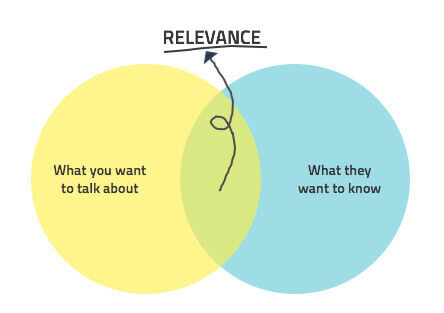
If you can find that area of overlap, you'll have cracked the code to learning how to write an eBook that has serious revenue potential.
That being said, you can also reach a point where over-analysis leads to inaction. If you're still feeling conflicted about choosing from amongst a pool of multiple eBook ideas that live at the intersection of your own interests and your audience's desires, my advice is to go with your gut and choose the topic you feel most drawn toward.
For example, if you were running a vegan food blog (like my girlfriend's, Vegan Anj), then one of the most impactful eBooks you could possibly write for an audience that's seeking help in making a transition to a vegan lifestyle, would include a full on vegan grocery list for shopping inspiration and a compilation of easy, attainable recipes to get started with. I'll soon be experimenting with some content of my own in this space over on my side blog, VeganTable.
Research the Competition
This advice applies to every piece of content you create—from writing a blog post all the way up to creating eBooks, courses, webinars or otherwise. Before you begin a new project, research your competition. It's always a good idea to see what others have already written, how they've written it and how successful it appears to have been.
Search for eBooks on the topics you're considering over on Amazon to see how many results there are, how the titles are framed and see the number of purchases (or reviews) those books have:
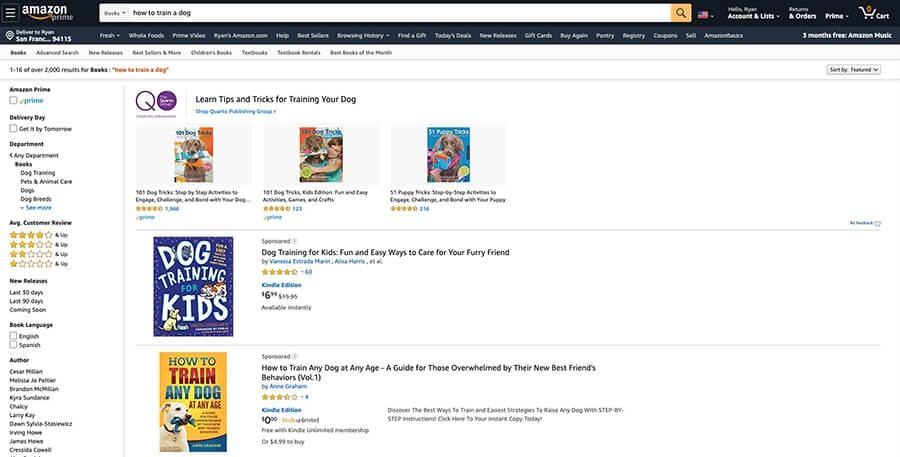
Poke around on the top ten blogs within your niche to see how much they've covered the subject too.
- Which exact topics have they covered in an eBook format?
- Have the eBooks you've been able to discover appear to be well-written?
- Are there any obvious gaps or shortcomings you could do better at?
If you're just now learning how to write an eBook and this'll be your first—I'd recommend steering away from topics in your niche that've been covered by hundreds (or thousands) of people in an eBook format.
This isn't to say you shouldn'teventually write an eBook about a topic that has clear demand, but rather that your efforts on your first eBook would be better spent on a more niche topic (with lower competition) that you can learn and build momentum with.
For example, if someone notable in your niche has just recently published an exceptional eBook covering a topic you're considering, it'll be a lot more difficult to outrank that person today. It's probably not worth your time as a beginning eBook writer to pursue that exact same topic—unless you're uniquely qualified to write an eBook that's significantly better.
However, you may find that the eBooks in a topic are you're considering are not well written, or provide very limited information. If this is the case, it may actually be a great opportunity to write something that'll really provide significantly more value to the readers in this space.
- What's a relatively popular topic that hasn't been satisfied well in your niche?
- What's something that you think people would be interested in, but no one is writing much about?
If you can figure this out, then you've hit a real sweet spot with your topic to write an eBook about.
One small caveat to this rule would be if you're converting a long blog post into a free eBook that can be offered as a downloadable resource your blog (like my free blogging books).
The benefit of this tactic, is that some of your readers who may be in a hurry often prefer grabbing a PDF eBook version of a longer blog post that they can return to later, like for example my guide about how to start a blog.
Do Keyword Research to Decide on Your eBook Title
Put simply, keyword research is a quick research process that many bloggers (myself included) use to come up with blog posts ideas that are all but guaranteed to eventually generate traffic—in order to confirm that people arealready searching for the topics they're considering writing about.
I recommend taking the free keyword research tool, Twinword Ideas, for a spin:
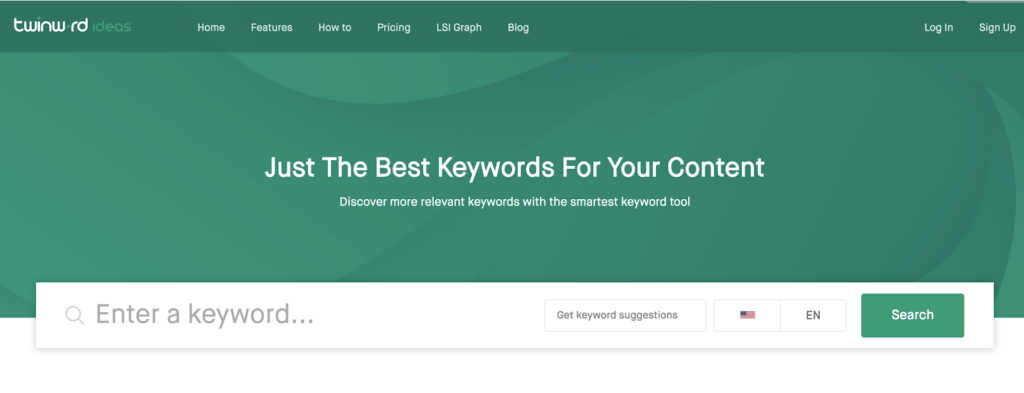
Doing keyword research before you learn how to write an eBook and really dive in, will help you identify what people are already searching for (as it relates to the topic of your eBook), and identify the best keywords or phrases to use in your title, in order to attract more readers.
When you write an eBook, you should absolutely use keyword research during the planning process, but primarily to help with the titling of your eBook—not as much for determining the actual subject matter of the content (which, as we covered should come more from the intersection of your interests and what your readers want more of).
2. Develop the Outline (and Structure) of Your eBook
The next step in the process of learning how to write an eBook, is to think about the overall structure you want to aim for and develop your outline.

What kind of formatting do you feel will work best for the eBook you want to write?
While there's no one single format that works for every type of eBook, here's an activity that'll help make your eBook accessible, logical and easy to read.
Start With an Outline of Your eBook
Beginning with an outline is a solid foundational start to any writing endeavor. That includes whether you're outlining a blog post, eBook, college paper, online course… you name it. You'll benefit from outlining your project first. My guide about outlining a blog post also details the exact same framework you'll want to use for outlining your eBook—and is a core tenant of writing faster over time.
Here's how to outline an eBook:
- Determine the key takeaways for your readers
- Craft a smart title (that'll entice readers)
- Write down every key question you need to answer in the eBook
- Arrange the major themes and sections of your eBook
- Ask more questions (research, research, research)
- Insert relevant studies, data and additional sources
- Revise, trim and clean up your eBook outline
- Write your eBook
The major benefit to beginning with a well-researched outline, is that it gives you a clear idea of what you're going to write about before you actually dive into the writing process. You can pick up my free outlining template right here:
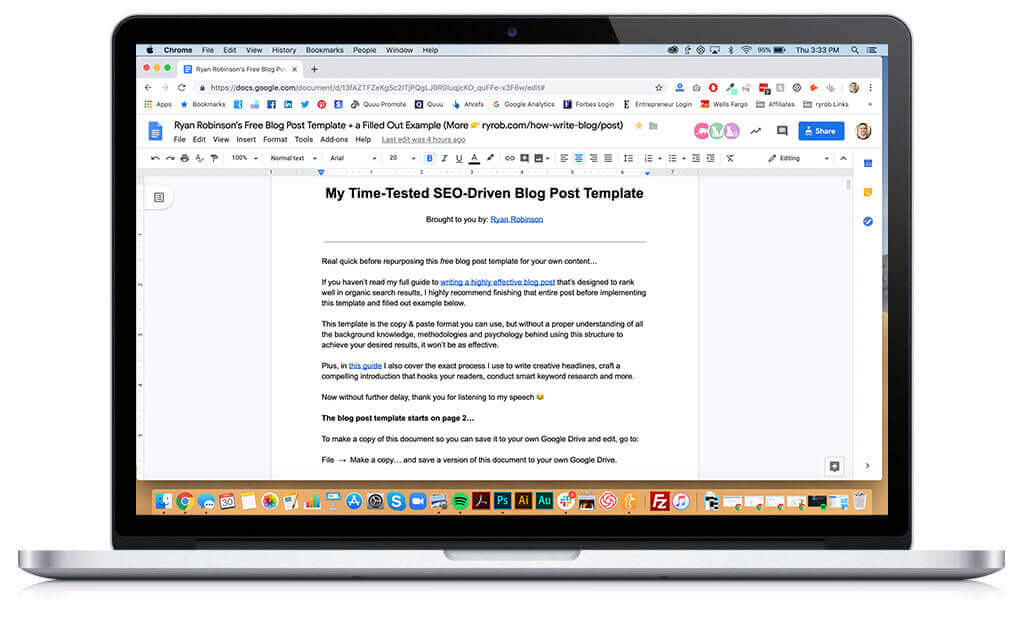
In this planning stage, you can decide which overarching themes will work well together—and what can be pruned out & reserved for another eBook at a later date.
Writing an outline first also keeps you from totally derailing off-topic during the writing process… or losing all sense of reality when you're up late at night trying to finish one more chapter.
Choose a Title That'll Make People Want to Buy Your eBook
Just as people will always judge a book by its cover, they also choose a book by its title.
Here are some quick tips to help you with picking the best title for your eBook:
- Don't go too generic. Write a title that'll stand out amongst the sea of other eBooks and won't be a replica of a book that's already written.
- Pick a title that's interesting to your readers. Exciting titles usually include these elements: An emotional appeal, a title that grabs people's attention, something that makes people curious, a humorous idea or a play on words.
- Choose a title that's easy to remember. If your blog readers (or shoppers on Amazon) read the title of your eBook, but don't purchase right away—they may try and search for it again later, so it pays dividends if your eBook title is memorable and catchy.
- Include your core keyword phrase. Remember the keyword research you did when confirming the general topic of your eBook? Be sure to include at least the main (most important and relevant) keyword phrase right in the title of your eBook, so that readers will instantly know what it's all about.
- Look for inspiration from other memorable titles. Are there any books you've read that have titles you'll never forget? Take inspiration from what works best about those titles and find a way to apply them to your own eBook.
Keep in mind that while your eBook titleis important, it's something that can also be changed later on before your publish date—so don't get too hung up with landing on your final title today.
It's ok to write your entire eBook with just a working title, and then come back to deciding on the final name after all of the content has been written. Plus, you'll have a much better sense of everything the eBook actually covers once you're finished, anyway.
Write a Killer Introduction
One thing that just about every successful eBook shares in common, is an introduction that really draws the reader in and sets up the rest of the book. Especially when it comes to eBooks on Amazon, where theLook Inside feature allows potential buyers to preview the first few pages of the eBook:
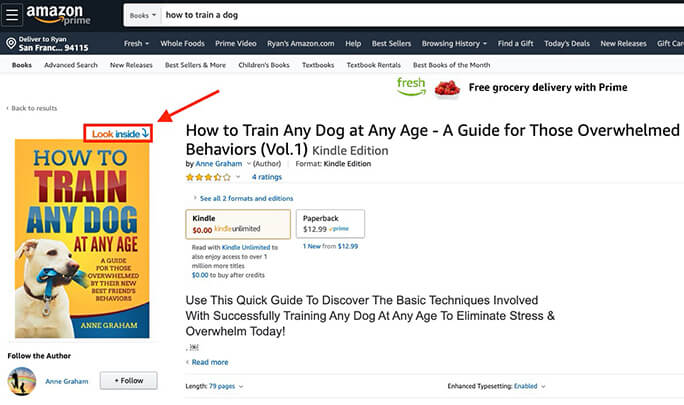
The introduction is usually a shorter section (compared to the rest of your eBook), which tells readers everything the book will be covering.
In particular, you'll want to use the introduction as a place to build up the problem your eBook will be solving throughout—and it's usually a great place to relate these challenges through use of a personal story that ties the narrative together.
Write Cohesive Chapters
Another thing great eBooks have in common are cohesive chapters that do a great job of offering succinct ideas, arguments or solutions in a step-by-step progression throughout the book.
This is another reason why you shouldn't just grab a bunch of random blog posts from across your site and haphazardly throw them together as an eBook that attempts to cover multiple related subjects. While each chapter should be distinct and offer a new idea, they should also work together to drive a point (or several points) home.
You'll also want to break your eBook chapters down into subsections.
While each chapter should address a main idea, think of the supporting components within that chapter as cohesive subsections that ladder up to presenting a compelling case for each chapter's big idea.
At the beginning of each chapter, you should write an introduction, and then use sub-headers to break the main idea down into smaller points that'll soon be expanded into the real meat of your eBook.
Conclusion with a CTA
At the end of your eBook, you'll want to write a clear conclusion that circles back around to your main idea. Seek to accomplish these goals with your conclusion:
- Recap the "big idea" you started the eBook with (the problem)
- Distill down and reiterate your main takeaway, explanation or argument (the solution)
- Give clear instructions for a tangible next step readers should take (call to action)
A successful conclusion to most eBooks should wrap up all of the main ideas—and direct readers toward taking clear action for implementing what they've learned in your eBook.
3. Map Out the Ideal Length and Start Writing Your eBook

How long should your eBook be? This is a common question many people ask when they're thinking about learning how to write an eBook for the first time.
- Does an eBook need to be as long as a print book?
- Should I consider the length of my eBook in terms of pages or word count?
Like with most things in business, the answer to these questions is… it depends on a number of different factors.
- An eBook can range from 3,000 words to well over 50,000+ words depending on the topic
- An average non-fiction print book is around 50,000 words, but eBooks are often shorter
So, with these loose benchmarks in mind, how do you determine the ideal length of your own eBook?
Well, you could start by aiming for something in the middle… say around 15,000 to 30,000 words. That would likely bring your page count to somewhere between 60 and 120 pages (double spaced), without accounting for any special formatting or the addition of images, pull quotes or custom graphics.
But, I'm not a one-size-fits all advocate. So, here are some questions to ask yourself that'll help guide you to the right answer for your own unique set of circumstances:
- What type of eBook are you writing?
- Who is your target audience for the eBook?
- What main point do you want to get across—or lesson are you teaching?
- How complicated is the concept to understand and take action on?
This doesn't fully answer the question, but… your eBook should be as long as it needs to be.
If you have a clear goal in mind with your eBook (you should), then your end point is going to naturally be when you feel confident that you've accomplished your mission.
Don't pad your book for extra length. Instead, write actionable, useful and poignant information for your readers to take real action on.
Let's use an example to illustrate this point…
We'll imagine a blogger wants to write an eBook for their travel blog.

Let's say our fictitious travel blogger wants to write about traveling to Edinburgh, Scotland. This eBook will serve as an in-depth guide and our author wants her book to include popular restaurants, places to stay, sights to see and a ton of reasons why Edinburgh is a worthwhile travel destination for all of her readers.
Instead of setting a specific word count goal for her eBook, she should first ask herself what information is essential to share with her readers.
- What will her eBook offer that'd make people want to read it?
- How will this be different from other similar guides that can be publicly read?
- What's the unique value proposition this book will promise to readers?
Next, she should ask herself if she's going to be giving extremely detailed answers within each section of her eBook.
- When she talks about the best restaurants, is she offering enough details to help a potential traveler?
- Will she only mention one or two popular restaurants, or should she also include lesser-known dining options?
Another important foundational question to ask during the eBook outlining process, is if the book has a logical flow from chapter to chapter. Does one chapter tie naturally into the next—and does she answer all of the questions she's raised in the eBook?
Lastly, has she met her own personal criteria for what her original mission was with the eBook? Has she created a resource that'll truly help a traveler get the most out of their trip to Edinburgh?
In the end, the question of how long your eBook should be—whether by word count or page count—isn't really about finding the "perfect length," but rather about deciding how much value you want to deliver (or can deliver) through the eBook.
You'll know your eBook is done once you've checked all of the boxes for your primary goals—and feel confident you're providing something of substance to readers. Just be sure this game plan ladders up to accomplishing your greater blogging goals, too.
4. Pick the Right File Format for Your eBook
Choosing the right file format to deliver your eBook in, is a bit of a technical decision, but a pretty simple one at that.

There are five main file formats that you'll want to consider saving your eBook in… but regardless of how you format your finalized eBook, I always recommend writing your eBook in a (free) Google Doc—as opposed to a Microsoft Word document, because the file will constantly be saved to your (free) Google Drive cloud storage as you write it.
The major benefit to writing your eBook in a Google Doc is that you won't lose your only copy of your eBook-in-progress if your computer crashes or gets stolen. Plus, you'll be able to share your eBook with any collaborators or editors you're working with, as the writing process unfolds and you'll all be able to make revisions, add comments & ask questions right inside the living document.
Now, before talking about the finalized file formats you'll want to familiarize yourself with, let's cover a few key terms to understand that go along with eBook formatting:
What is Digital Rights Management?
Digital Rights Management (DRM) is a term you'll most likely come across while learning how to write an eBook—and it has to do with the copyright access of your eBook.
DRM is put in place so that only people who have rightfully gained access to your eBook (i.e. purchased it or signed up for your email newsletter) are legally granted access to see it. In most cases, once a person has purchased your eBook, they're allowed to view the contents of it.
The specifications of your DRM can also limit where the content of your eBook can be viewed too. For example, if you buy an eBook on Amazon, you'll likely only be able to view it on your Kindle device or with a Kindle app on an iPhone or iPad, for example. That's Amazon's own form of DRM in place, which makes eBooks sold on their platform very secure compared to the alternative of selling eBooks in PDF format to your blog audience.
For most eBook authors (like myself) that are selling eBooks at a relatively low price point ($7 to $15) directly to reader, or simply giving away most eBooks as lead magnets to promote my blog and build relationships with my readers—a simple copyright statement clarifying ownership of the eBook within the first few pages and a reminder in the footer on all pages of your eBook, is usually enough of a DRM statement.
Having a DRM statement on your eBook doesn't mean that it's theft-proof either, but it does limit the number of people who take the extra step of sharing your eBook without your explicit permission.
Understanding Reflowable Layout vs. Fixed Layout eBooks
The formatting of an eBook comes in two main categories:
- Reflowable layout
- Fixed layout
Many bloggers know what it means to have a responsive WordPress theme for their blog. This means that your blog will look great on desktop screens, laptops, tablets and mobile devices. Your blog theme will adapt and move around the text and images—to make it aesthetically pleasing and prevent visual overlap that could otherwise make it difficult for readers to consume your content.
Many eBook formats have a similar decision to make—and when an eBook works across devices, it's called reflowable.
A reflowable eBook will automatically adjust the font size and move images around to provide a better user experience for reading the eBook on all types of devices.
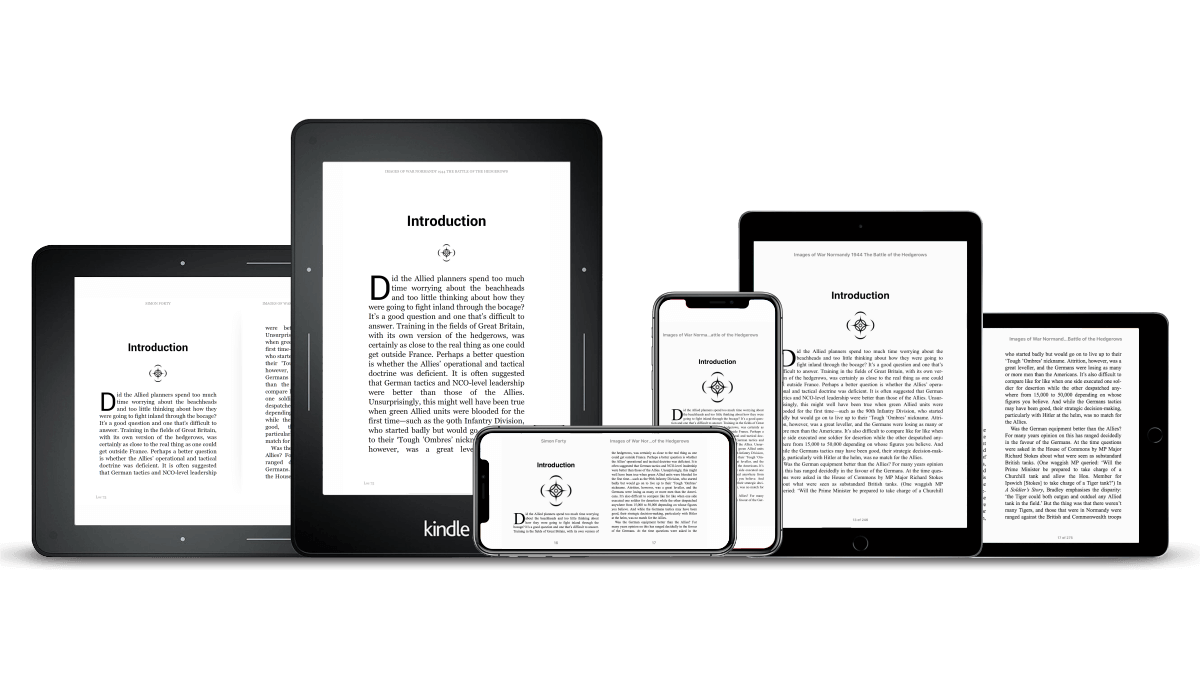
While most choose to learn how to write an eBook and publish it in a reflowable format, some authors will opt for a fixed layout instead (like a PDF).
This means that text and images will stay exactly where the you place them within your eBook. A fixed layout can work well on a specific device, but does not work well if a reader attempts to transfer the eBook over to another device that the content isn't specifically formatted for.
So which eBook layout format is better?
Personally, I've used both (and still do). That being said, I recommend using a reflowable format for the publishing of most eBooks today, which makes them more useful to the majority of readers. However, if your eBook is very image-heavy, or if changes in the design would lead to a poor user experience, then a fixed layout might be a better solution.
Examples of eBooks that would actually benefit from a fixed layout include things like:
- Children's books
- Photography books
- Recipe books
Now that we're familiar with these terms, let's weigh the pros and cons of the 4 different file formats that you should consider when learning how to write an eBook (and publishing it).
PDF (.pdf) eBook File Format
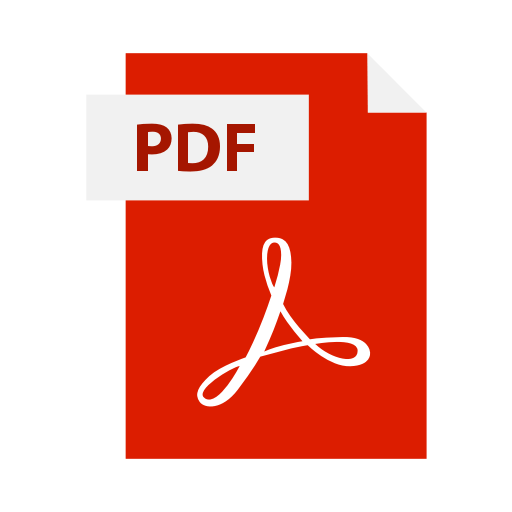
PDF (Portable Document Format) is a file format that just about everyone outside of the eBook world is already familiar with.
Originally designed and released by Adobe in 1993, PDF files are probably the easiest to publish an eBook in—and for your readers to quickly download & read. You can export any Google Doc or Microsoft Word document directly into PDF file format.
The downside of publishing your eBook as a PDF file though, is that it will not be reflowable, so it's not ideal if you hope for readers to access your eBook on multiple different devices. You'll want to design the layout of your eBook for the device you anticipate most readers consuming it on.
Another drawback is that PDF files cannot be sold on Apple iBookstore or the Amazon Kindle store, because they have only the most basic copyright protection, and can easily be shared for free.
EPUB (e.pub) eBook File Format
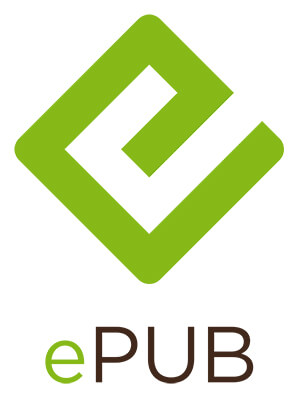
The EPUB file format is widely supported and very popular in the eBook industry. This format can be used to view content on many different devices like computers, eReaders, smartphones and tablets. One major exception though, is the Amazon Kindle… which does not support EPUB files.
Another major pro of this file type is that EPUB files are heavily DRM protected and you can choose whether you'd like your eBook to be reflowable or have a fixed layout during the design and publishing process.
Kindle File Format (KFF, AZW, AZW3) eBook File Formats
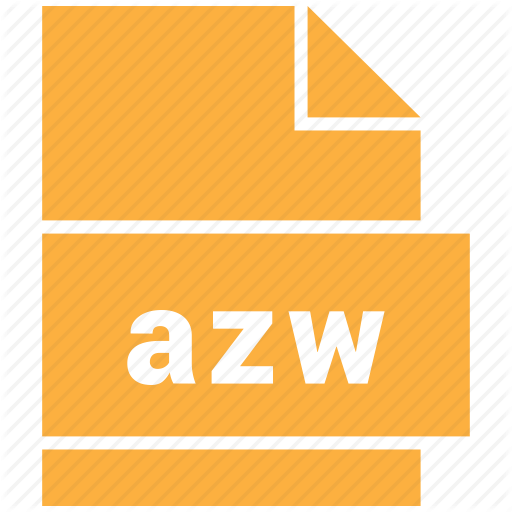
For eBook authors that are interested in selling your eBooks on Amazon (that should be you), the KFF (or AZW) file format is going to be a must for publishing your eBook.
Amazon previously used the MOBI file format for eBooks that were sold on the Amazon Kindle store, but recently updated this to their AZW formatting (which stands for Amazon Word) in order to give a higher level of DRM protection to eBooks—and to limit access of viewing content strictly to Kindle devices and Amazon-owned apps.
AZW3 is currently the most up-to-date version of the AZW file format—designed to be fully reflowable—and is used on all readers after the introduction of Amazon's Kindle Fire. AZW3 is more advanced than the original AZW file format and supports more fonts, styles and layouts, which make it a great reader experience on all Kindle device types.
TXT (.txt) eBook File Format
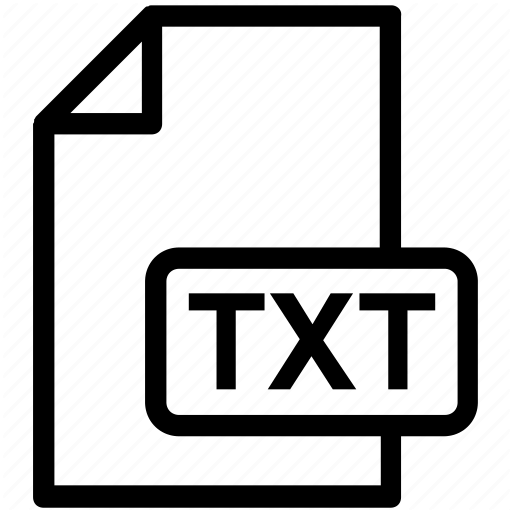
If you want to write an eBook and publish it only in plain text (which would make you a pretty rare breed), then the last eBook file format you should consider is the TXT file. That being said, a TXT file is one of the most simple, straightforward and smallest of all eBook formats you could publish in.
This wouldn't be my top recommendation for a file format you should publish your eBook in, but it could be a valid option for an eBook that's extremely text-heavy and long, as this file format does allow for a very small file size (which can also be more easily downloaded over slow Internet connections).
What's the Best File Format to Publish Your eBook in?
Unfortunately, writing and selling eBooks today means that you'll want to publish your eBook in multiple different file formats.
Giving your readers multiple options is the best call.
- Listing your book on Amazon? Then you'll need to use the KFF (AZW3) file format over there
- Want to offer a clean, reflowable eBook via direct sales to your readers? The EPUB file format will probably be your best bet
- Prefer to publish your eBook in a fixed layout? A PDF file will be your easiest option
My advice? Use the right eBook design tool (which we're talking about next) that allows you to publish your eBook inall of these file formats with the click of a button.
5. Design an Eye-Catching eBook Layout (and Cover)
Once you've actually written your eBook, the next step is to design the layout and cover of your eBook.
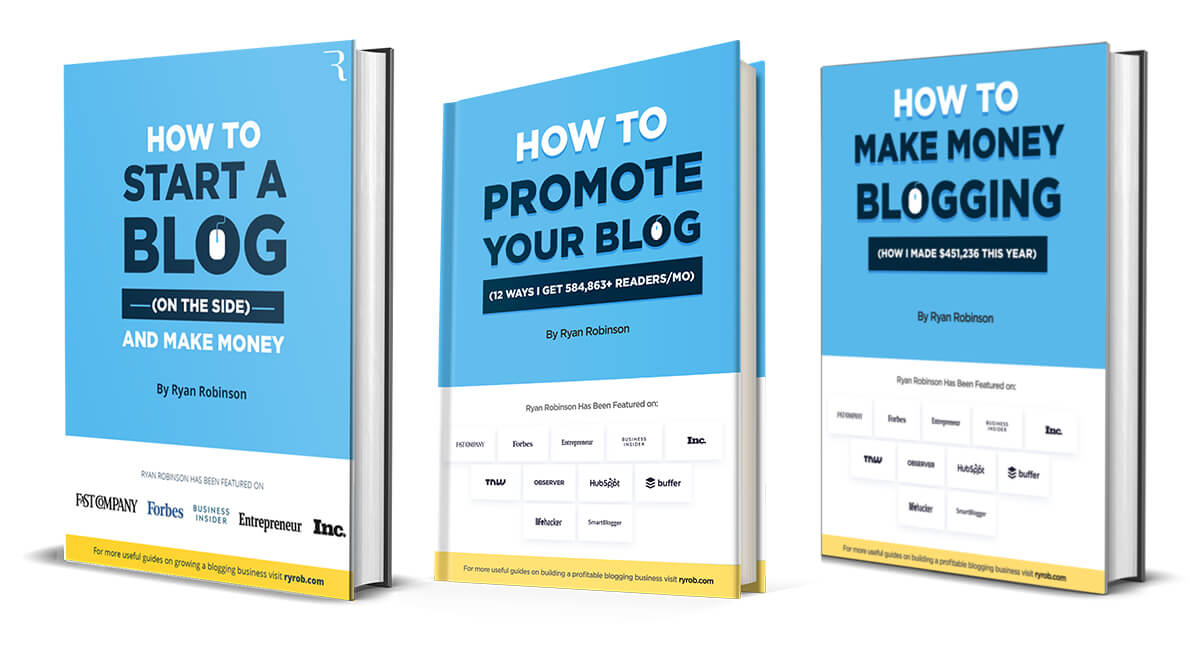
The design aesthetic of your eBook, is going to be an integral aspect of your readers' overall experience—so believe it or not, the layout and cover design of your eBook both matter quite a lot in the grand scheme of eBooks. A beautiful design with a professional look will increase your credibility and the likelihood that readers will want to share your eBook with others they know.
So how do you design your eBook layout and cover to impress your readers?
Choose a Readable and Attractive Typography
As you've probably already done with your blog layout decisions, choose to use fonts in your eBook that people can easily read (and also match your branding).
My recommendation is to go with very common, easily legible fonts like:
- Arial
- EB Garamond
- Josefin Slab
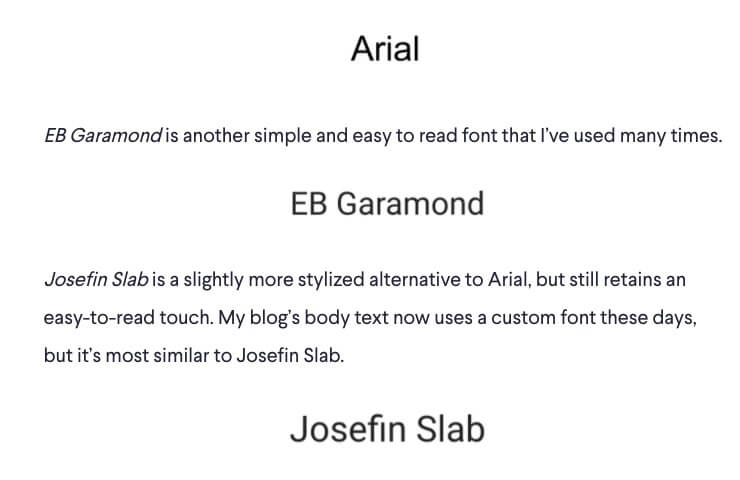
You do have some more flexibility with your eBook fonts though (compared to the fonts you'd choose for a more public-facing blog). So, depending on the format you learn how to write an eBook and publish it under—and of course the type of device your readers will be using—they may even be able to change the font size and type on their own, anyway.
Use Chapters, Headers and Subheaders
When it comes to writing anything on the Internet, recent blogging statistics show that most people skim text. It goes to suggest that if your blog has huge sections of text and no headers to visually break things up a bit, most people won't spend the time trying to find the information they want… they'll simply leave and find their answers elsewhere.
The same principle should apply to your layout when you sit down and learn how to write an eBook that'll answer your reader's primary questions—and keep them engaged enough to continue reading.
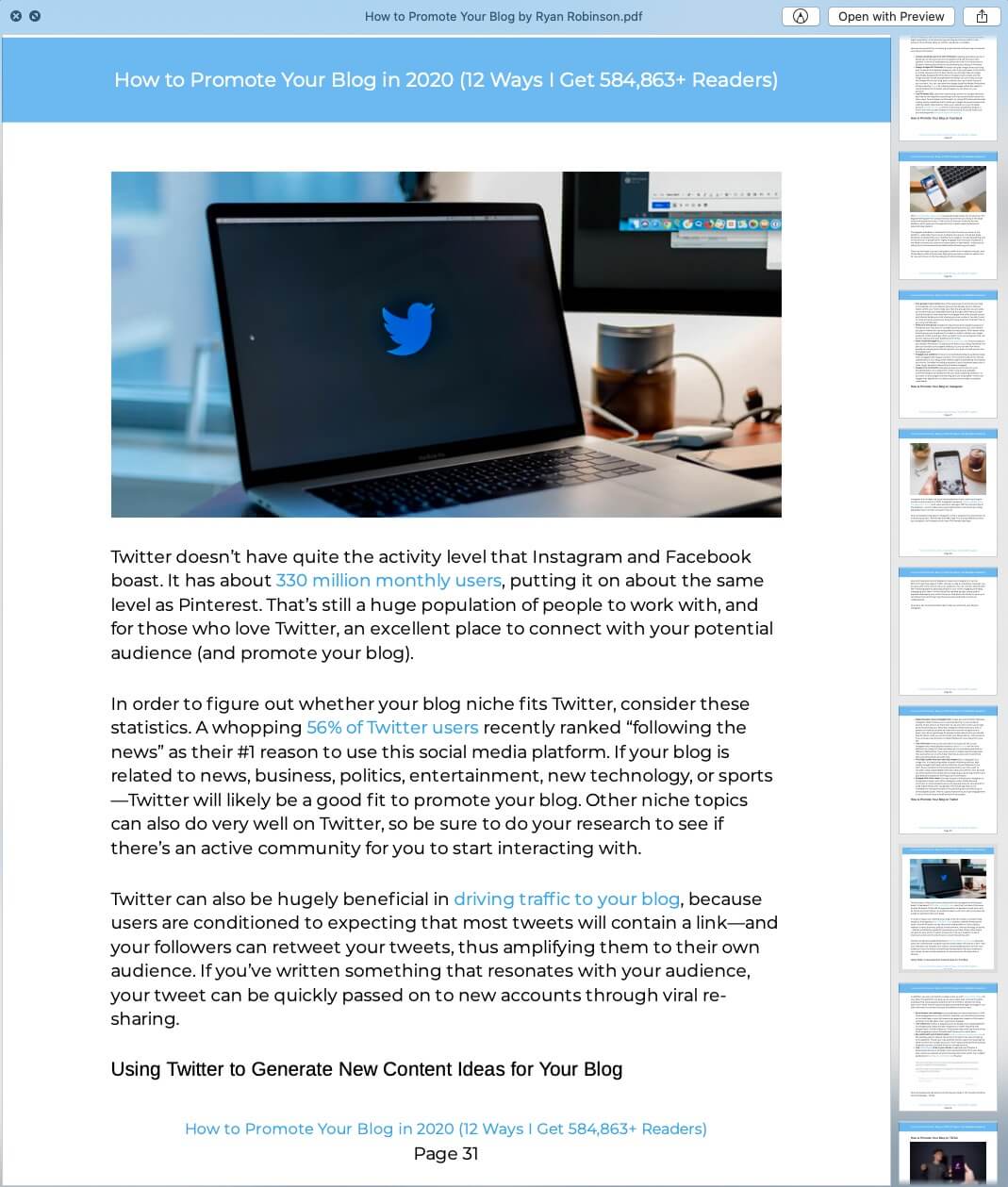
With eBooks, you have a little more freedom to write longer paragraphs than you do when writing a blog post, but it's still important to use chapters, headers and clear subheaders to visually entertain your readers while they're navigating your eBook (and it'll help them avoid overwhelm too). Using this kind of formatting makes your eBook more organized overall and thus, easier to read.
Extend Your Blog's Branding to Your eBook
Most bloggers work hard to establish a clear brand and make their content visually stand out from the sea of competition.
These decisions range from choosing cohesive color schemes, to fonts, logos, images and even deploying the right blogging tools that match their brand's perceived image. Your eBook should be a very natural extension of the branding you've already started over on your blog.
So for example, I've chosen to use a very minimalist design style on my blog here. I also use bold, easy to read fonts, and the color blue is a commonality across all of my pages. I can easily transfer many of the same design elements over to my eBook layout & design.
Here's the book cover from one of my free blogging books—the eBook titled How to Promote Your Blog:
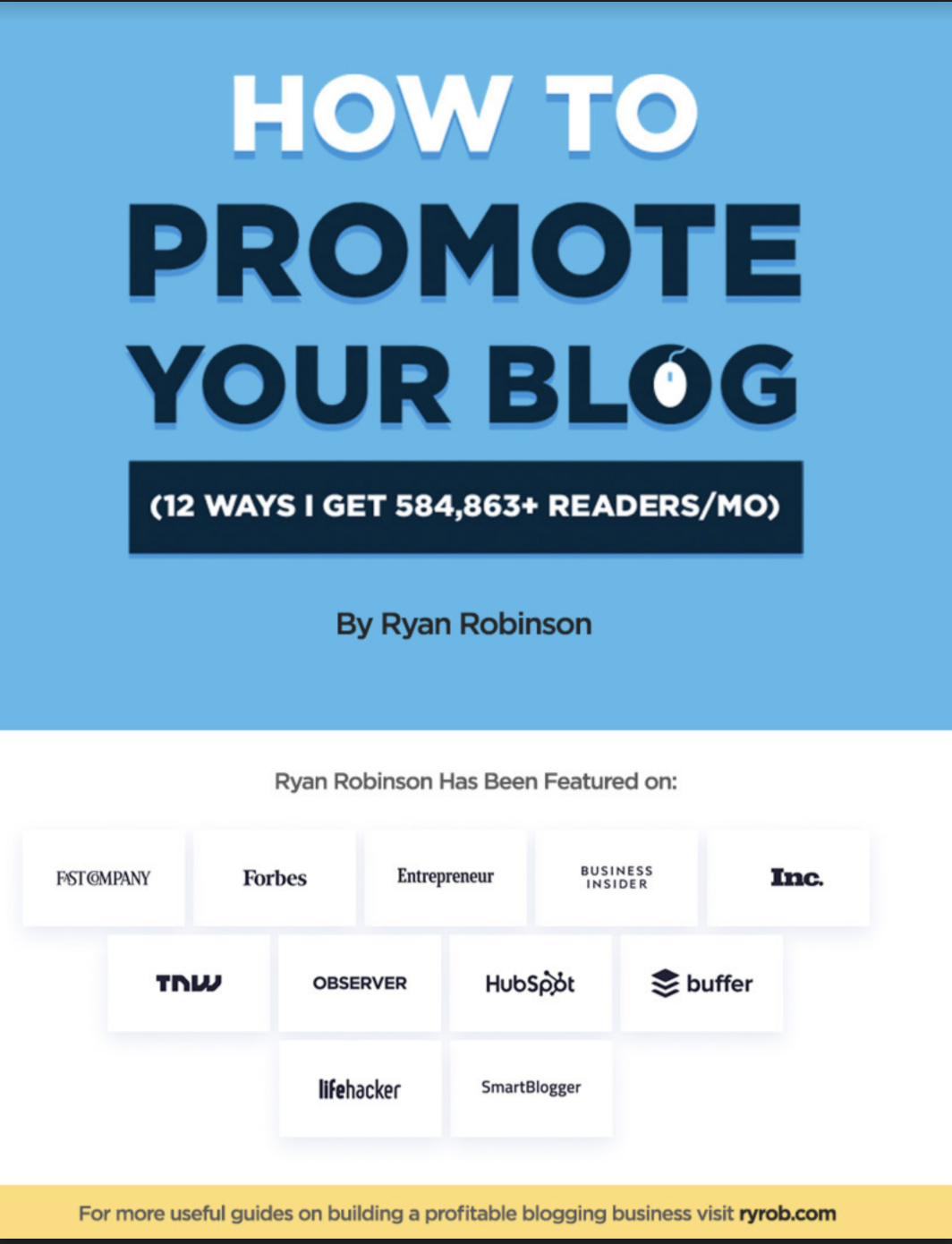
You can see that the cover pulls from some of the key design elements of my blog layout (pictured below), ranging from font types to images, verbiage and more.
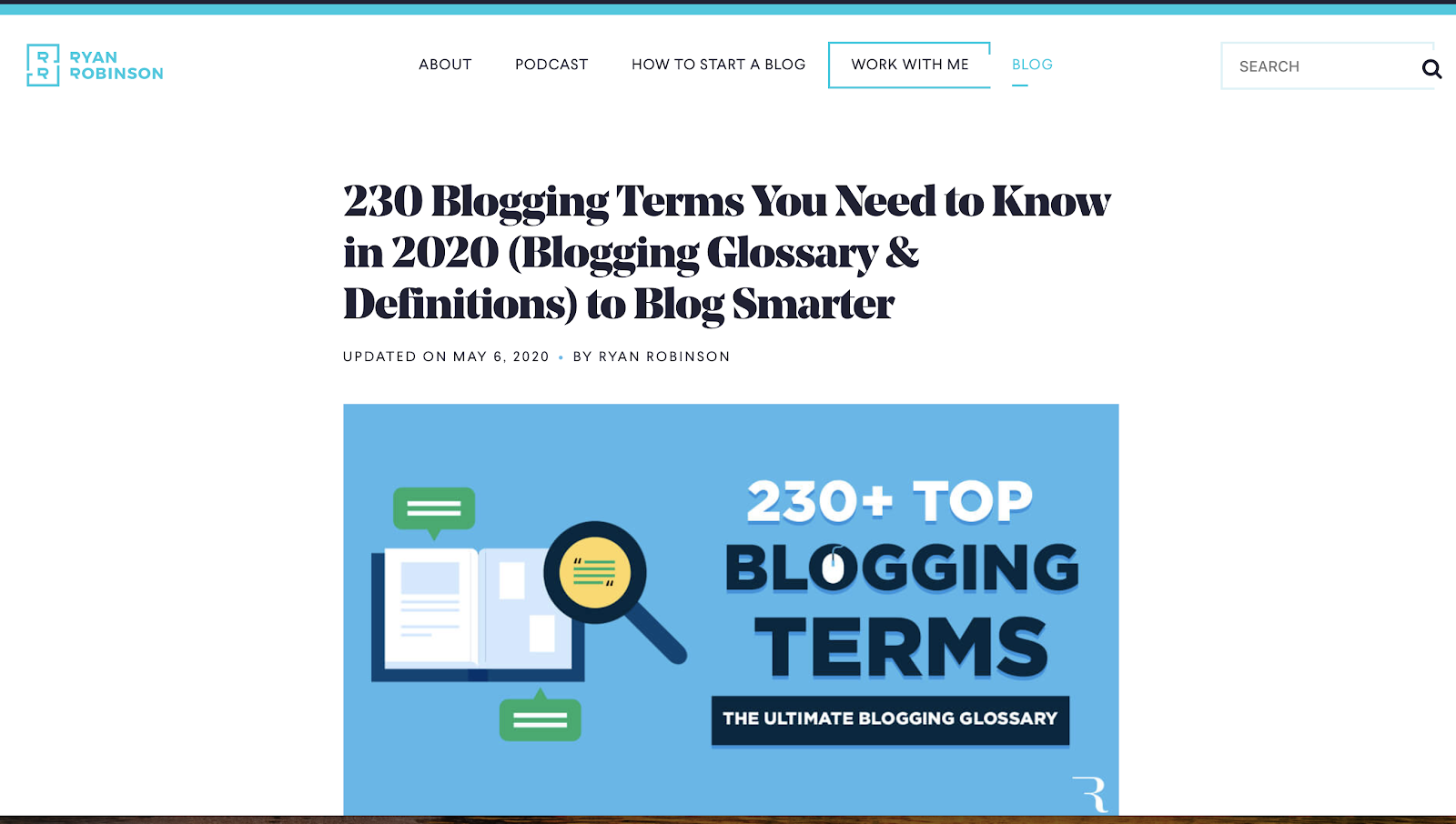
Your primary goal should be to learn how to write an eBook that's extremely effective athelpingyour readers—but a close secondary goal should be to deliver an eBook that also looks and feels like a premium extension of the content already living on your blog.
Include Images in Your eBook
Like clever use of formatting, adding rich images in throughout your eBook will also help make your content a lot more appealing (and interesting) to your readers.
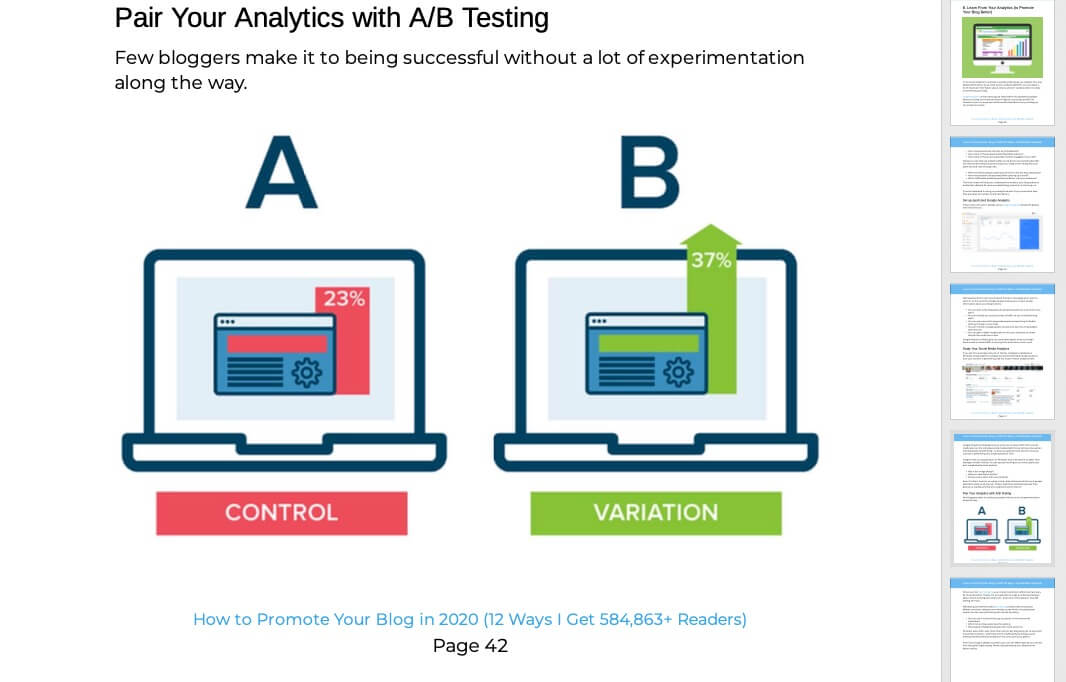
Not only does it break up long walls of text, images can help people connect more easily with your content (and better understand a point you're trying to communicate).
Design an eBook Cover That People Will Love
The cover of your eBook may actually be the difference between someone being interested enough to buy your eBook—or passing it over and grabbing your competitor's.
Your eBook cover doesn't have to be fancy, but it should look clean, professional, appealing and of course match the overall design aesthetics of your blog (if you want to create a clear connection between your eBook and blog… which I strongly believe you should strive to do).

Depending on your blog's niche, you may need to take more time to work on designing your eBook cover. For instance, if you're in a creative niche, your audience may expect something that looks like an originally designed graphic (if you're in the design space), originally shot photography (if you're a photographer) or otherwise.
If you're already invested in your community, you should have a pretty clear idea of what kinds of eBook covers tend to already do well in your space. And if you need some inspiration, take a spin on the Amazon Kindle bookstore in your category to see what lessons you can take and apply to your own cover design.
If you're not comfortable designing a cover for your own eBook, you could easily higher a freelance graphic designer on a site like 99Designs to produce one for you.
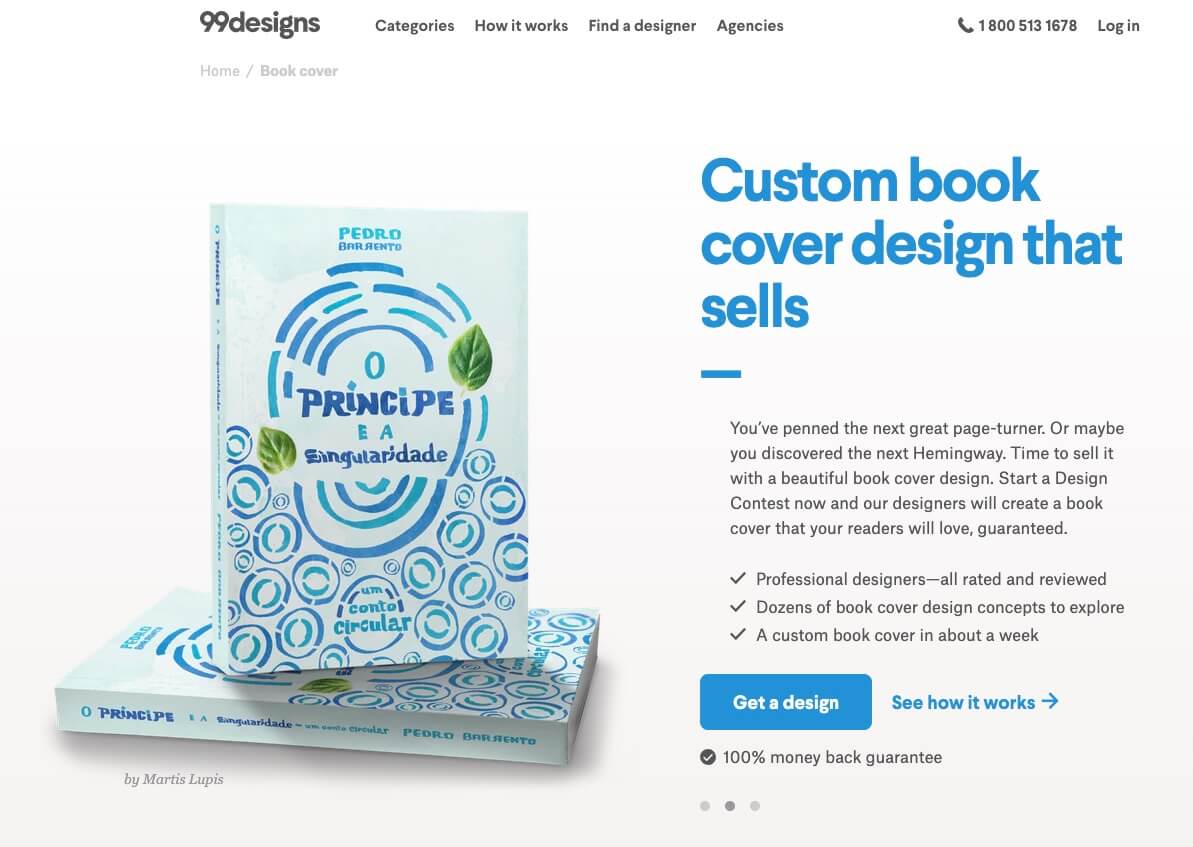
Most eBook cover designs will run you around $199 from the talented designers that'll compete to win your project on 99Designs, but the high quality end result is well worth the one-time expense. Plus, you'll own the full rights to your cover design without any strings attached.
6 Best Tools for (Quickly) Designing Your eBook
Designing your eBook is a lot easier when you have the right tools to work with. Here are some of the best eBook layout and design tools you can use to put together a great looking eBook.
1. Designrr
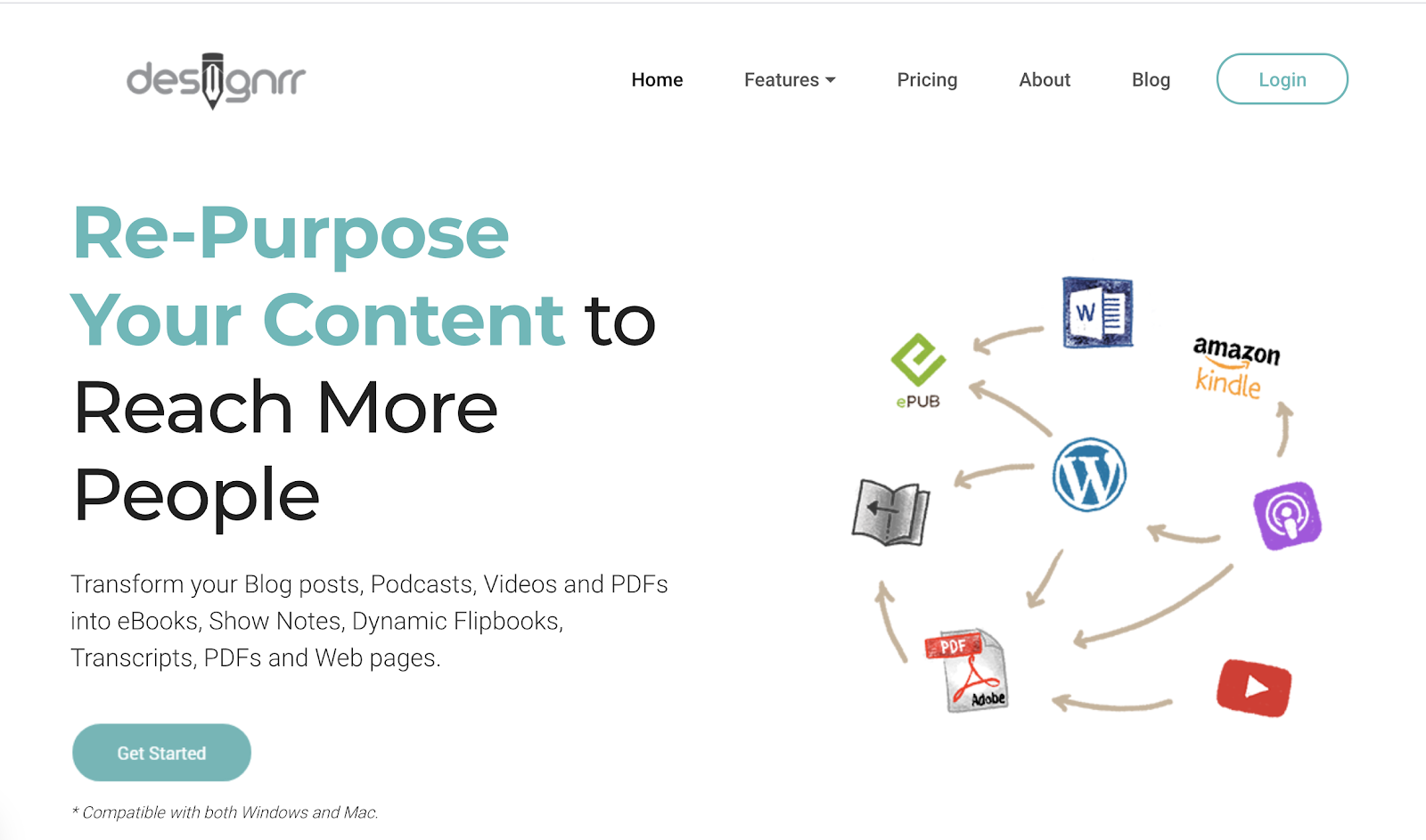
Designrr is hands down the best new do-it-yourself eBook layout and cover design tool I've found in the past few years, which is why I use it with my own eBook layouts (and cover designs).
One of the main appeals of Designrr, is the ability to easily repurpose content that you've already created in the form of blog posts, podcasts, videos and PDFs. You can compile your eBook from multiple different sources using their upload tool. If you want to combine a blog post, podcast interview and YouTube video to form one eBook on a subject, you can do that.
You can get transcripts of podcasts and YouTube videos for additional content too (reducing a lot of effort). Then, once you've chosen your content, you can upload it into the layout design feature, pick from a library of pre-made eBook layout templates and then edit your design any way you'd like. This part is highly customizable, allowing you to change fonts, colors, formatting and more. You can also resize images and move them to new locations through your eBook.
If you've gone through the process of learning how to write an eBook and have it sitting in the format of a Google Doc, you can use Designrr to quickly import it design it into a beautiful looking eBook with just a few clicks. At the end of your design process, Designrr also gives you the option to export your eBook in all of the top formats you could need—including PDF, Kindle, EPUB and HTML. Side note—if you do choose to start a podcast, just be sure to get the best podcast hosting too.
2. Canva
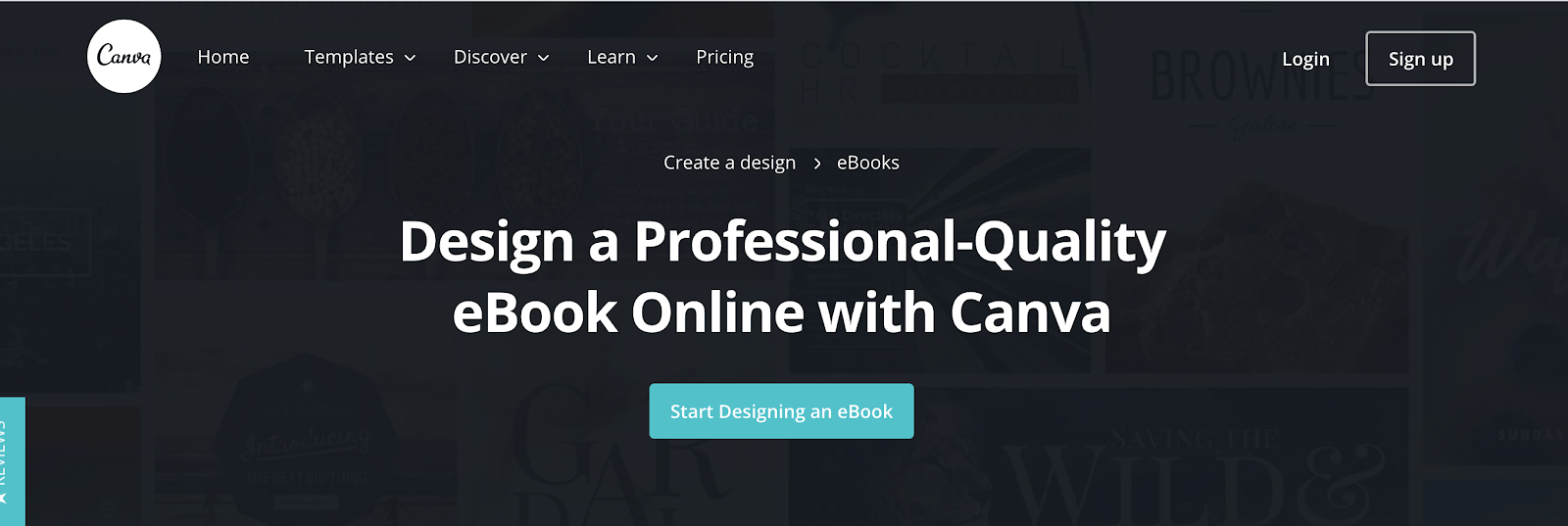
Canva has both a free and premium version of their tool—and it's a great option for designing eye-catching visuals, especially for those not especially tech-savvy. With Canva, you can start by choosing from pre-made templates, upload your own photos, use stock images, adjust images, add filters, and add/edit text. Canva is most useful in designing your eBook cover.
Almost everything about their design tool suite is free, but some of the images and custom designs on Canva will cost you up to $1/ea to use. Unlike Designrr, which allows you to export your eBook into a variety of formats, the primary export format you can use with Canva is in the form of a PDF.
3. Visme
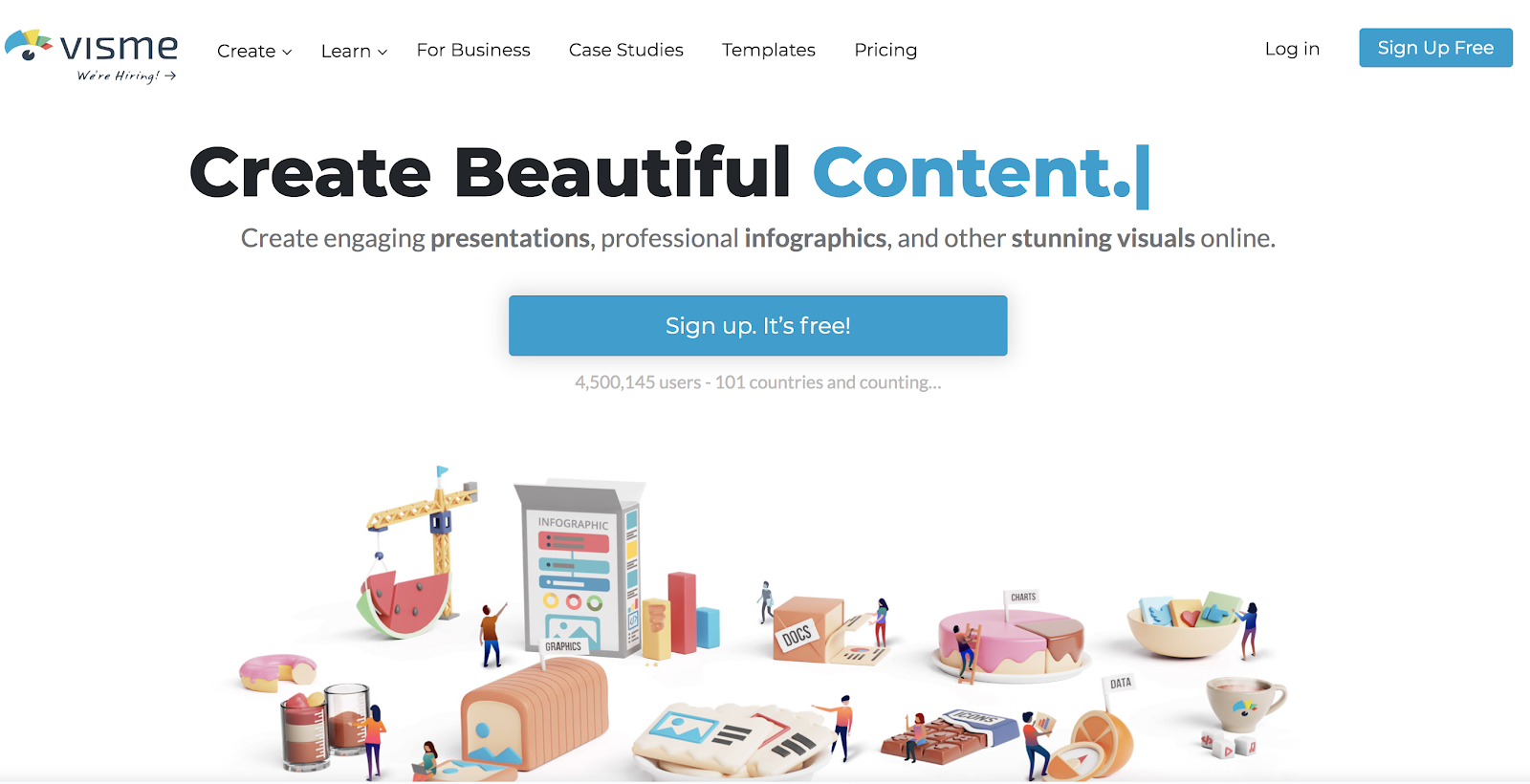
Visme is very similar to Canva, but possibly a little easier to use from a user-experience standpoint. It doesn't take very long to create an eBook with the Visme design tool (and it's useful for more than just cover designs too).
The steps are fairly easy to follow, starting with choosing an eBook layout template. Visme uses content blocks to let you move around your content where you want. This design software also lets you include and edit graphs, images, charts, visuals, colors and fonts during your layout design process. The biggest downside though, is that Visme only allows you to export your eBook in PDF format.
4. LucidPress
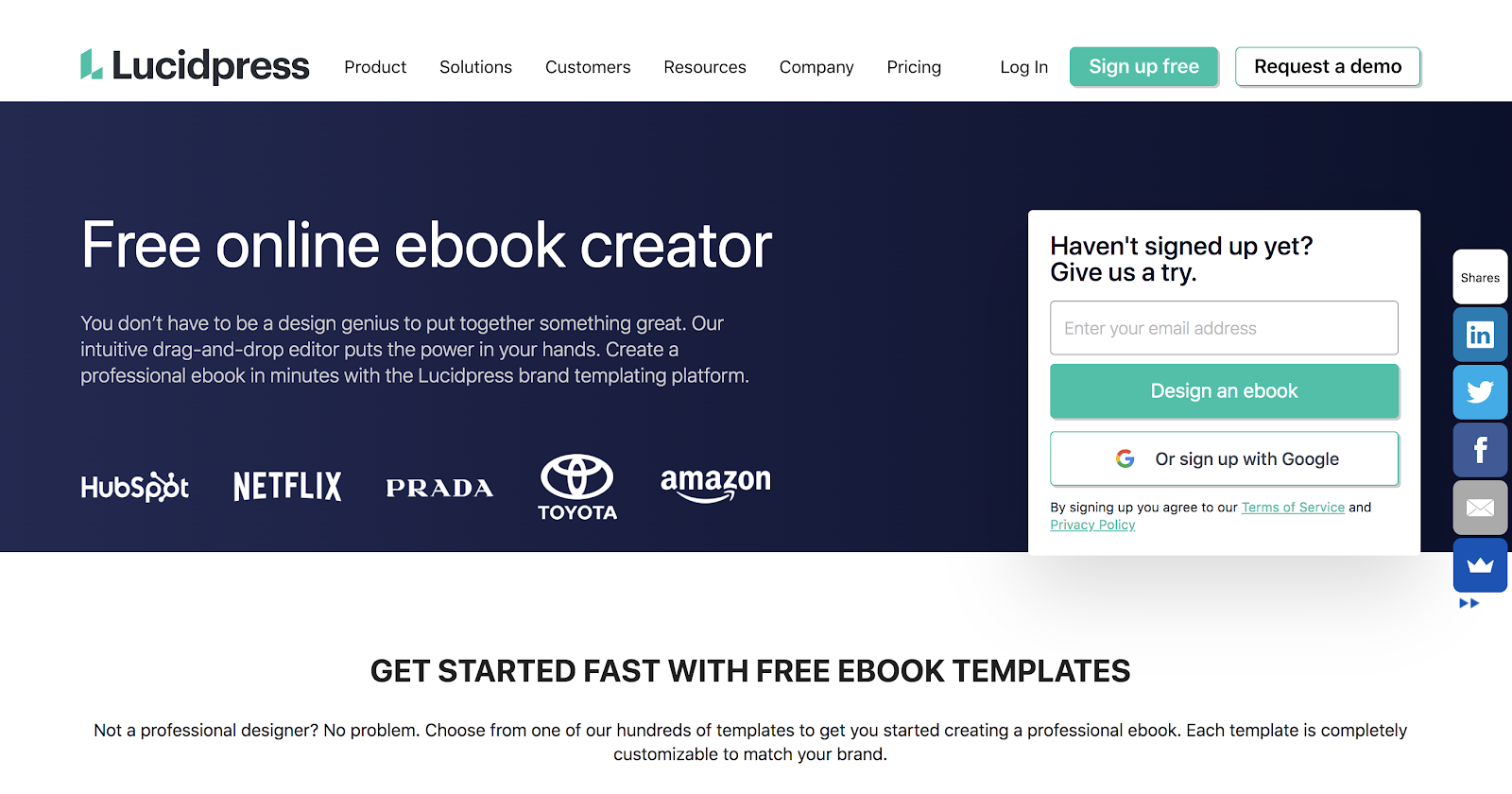
LucidPress is a branding tool, and one of their primary features is an eBook creator that uses a simple drag-and-drop editor. Their eBook design software comes with preset templates that you can choose from, or you can choose a blank eBook format to construct your own from the ground up.
LucidPress allows you to set branding preferences like color, fonts and images that are stored so you can quickly customize your eBook design to match that of your blog. Other features with LucidPress include data automation that allows you to auto-populate information, and easy import integration with Google Docs, YouTube, Drobbox, Facebook and inDesign.
The basic version of LucidPress is free, but they offer premium versions with more advanced features (which you'll probably want to use once you see them). The main drawback of LucidPress though, is that your eBook can be exported only as a PDF file.
5. Venngage
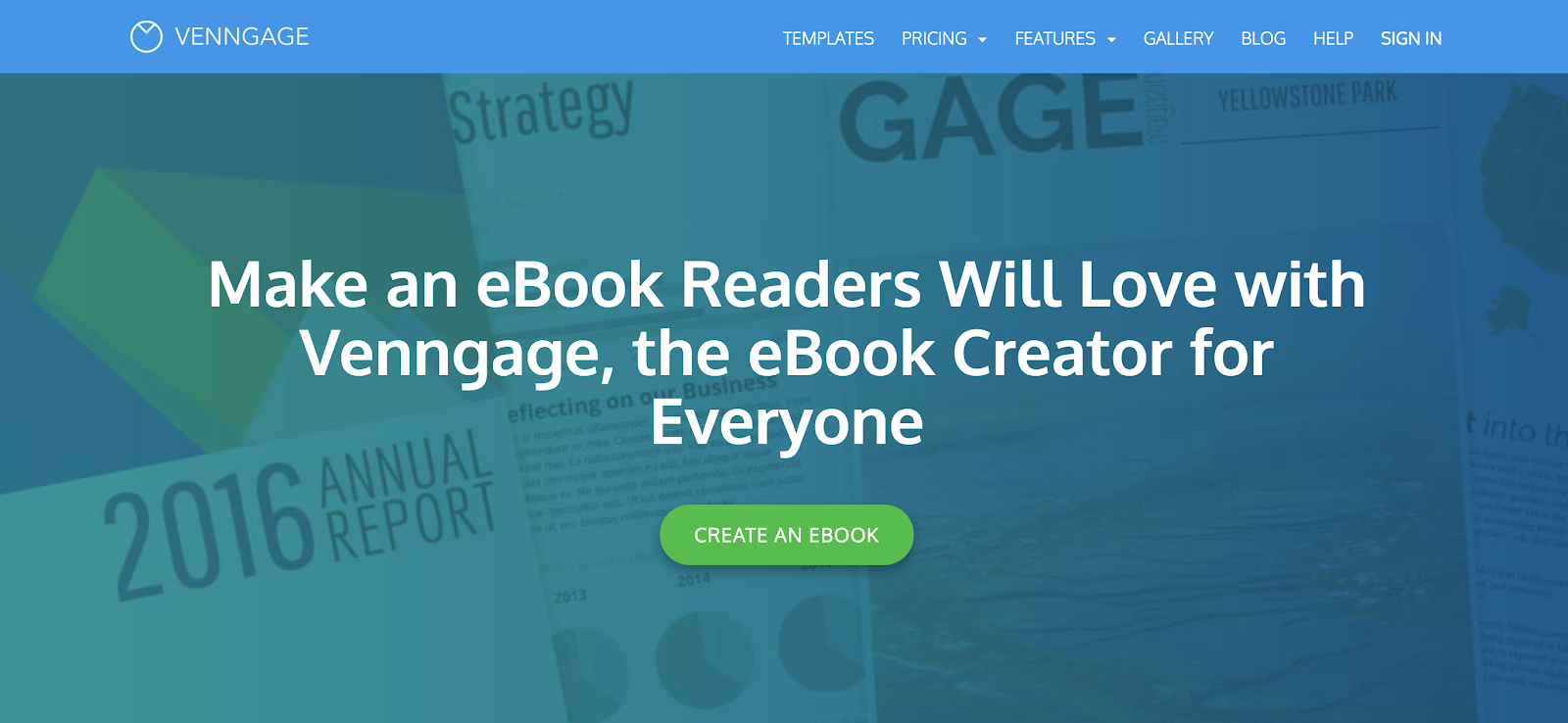
Venngage started out as an infographic tool, but they've grown to include an eBook creator that's marketed for "beginner" eBook designers.
Signing up for Venngage is free, and they offer a variety of free templates to use for laying out your eBook. Fonts, colors, images and charts are customizable with their fully online design tool suite. However, as with most of the design-first tools in the eBook industry, Venngage designed eBooks can only be exported as PDF files.
6. Scrivener
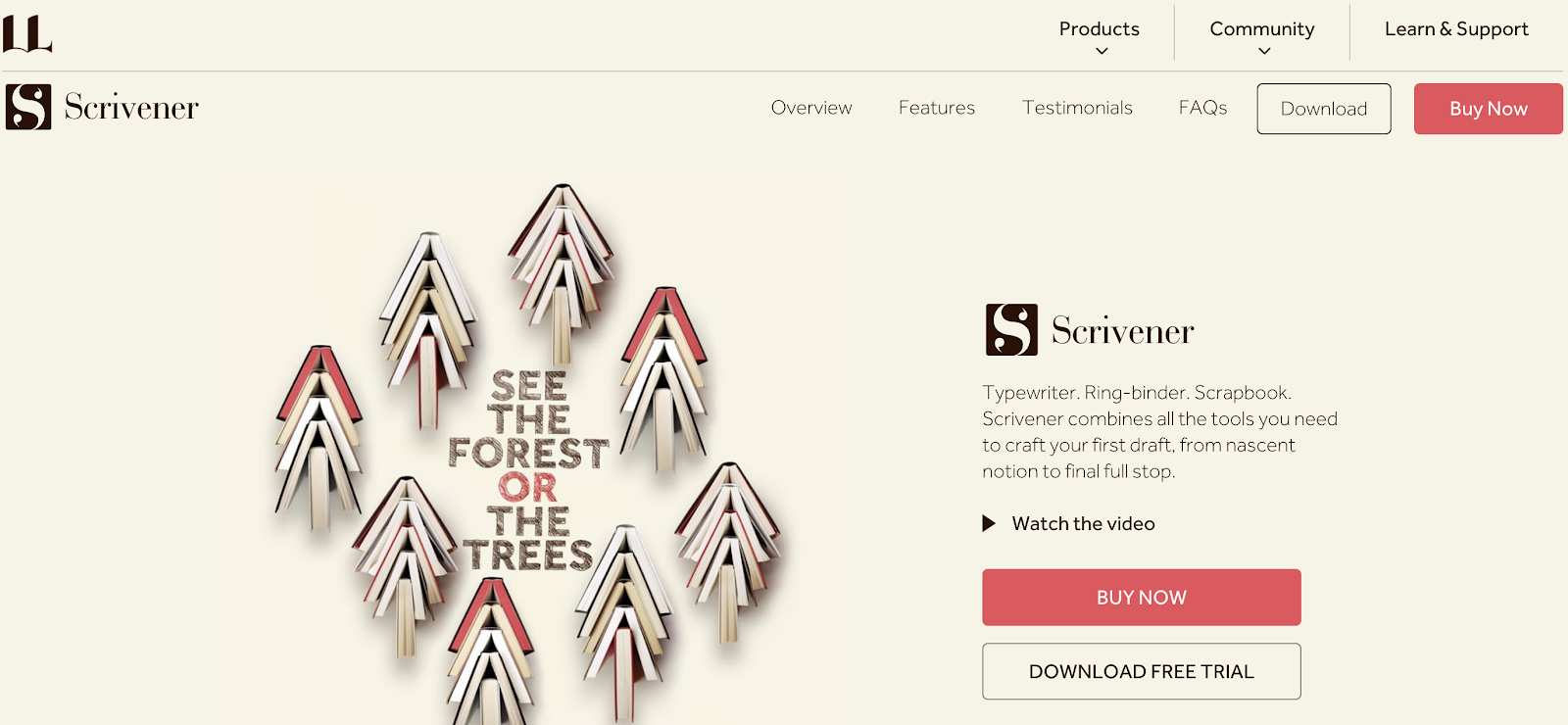
Scrivener is the classic (oldest) tool for writing an eBook and laying out the design, but until very recently the software has been a bit outdated. Not long ago, Scrivener came out with an update that upgraded the tool to Scrivener 3, which has made it compatible with macOS and they also overhauled the user interface. Other new features include:
- Epub3 and Kindle export features
- Custom metadata for including things like checkboxes, dates and list boxes
- Draft and session progress bars (to monitor your eBook writing progress)
- Enhanced outlining features
Even with the enhancements to Scrivener in the past year, I'd still rank Designrr as my top choice as an eBook design tool by far—even if only for the fact that you can export your eBook into every file format you'll need to sell the eBook on various different platforms.
All things considered, Designrr is a great deal more modern and easier to use than Scrivener, despite the fact that the tool has been around for a long time.
6. Sell Your eBook to Your Existing Audience
Who should you sell your eBook to first? The best answer is, the people who already know, read and like your content.

If you've already been blogging for a bit of time, your existing audience is already primed to enjoy more your writing—especially those who've opted to join your email list. That's why your own audience needs to be the first place you turn when it comes to your eBook promotion efforts.
So, what's the best way to promote your eBook to your audience? Here are some actionable steps for ramping up your initial eBook sales.
Build a Landing Page for Your eBook
Now that you've written about the right topic for your eBook, and you've chosen a design you're happy with—the next step is to create a landing page where people can purchase (or access) your eBook.
A landing page gives people a place where they can learn more about you, your eBook and hear exactly why it's going to be useful for them. They also need the opportunity to either purchase or download it, directly on the landing page. Now, let's talk about how to make a strong landing page to promote your eBook.
Keep Your eBook Landing Page Short and to the Point (for Free eBooks)
There are times when a long-form landing page can really showcase the benefits of your eBook and sell readers on why it's worth their investment. This is especially true if your readers are paying for your eBook—and becomes increasingly more important as the price of your eBook goes up in value.
If your readers are already familiar with your eBook—or if you're offering it for free—then a short landing page will likely be better. For example, here's a snapshot of my landing page for a set of free blogging books I offer my readers:
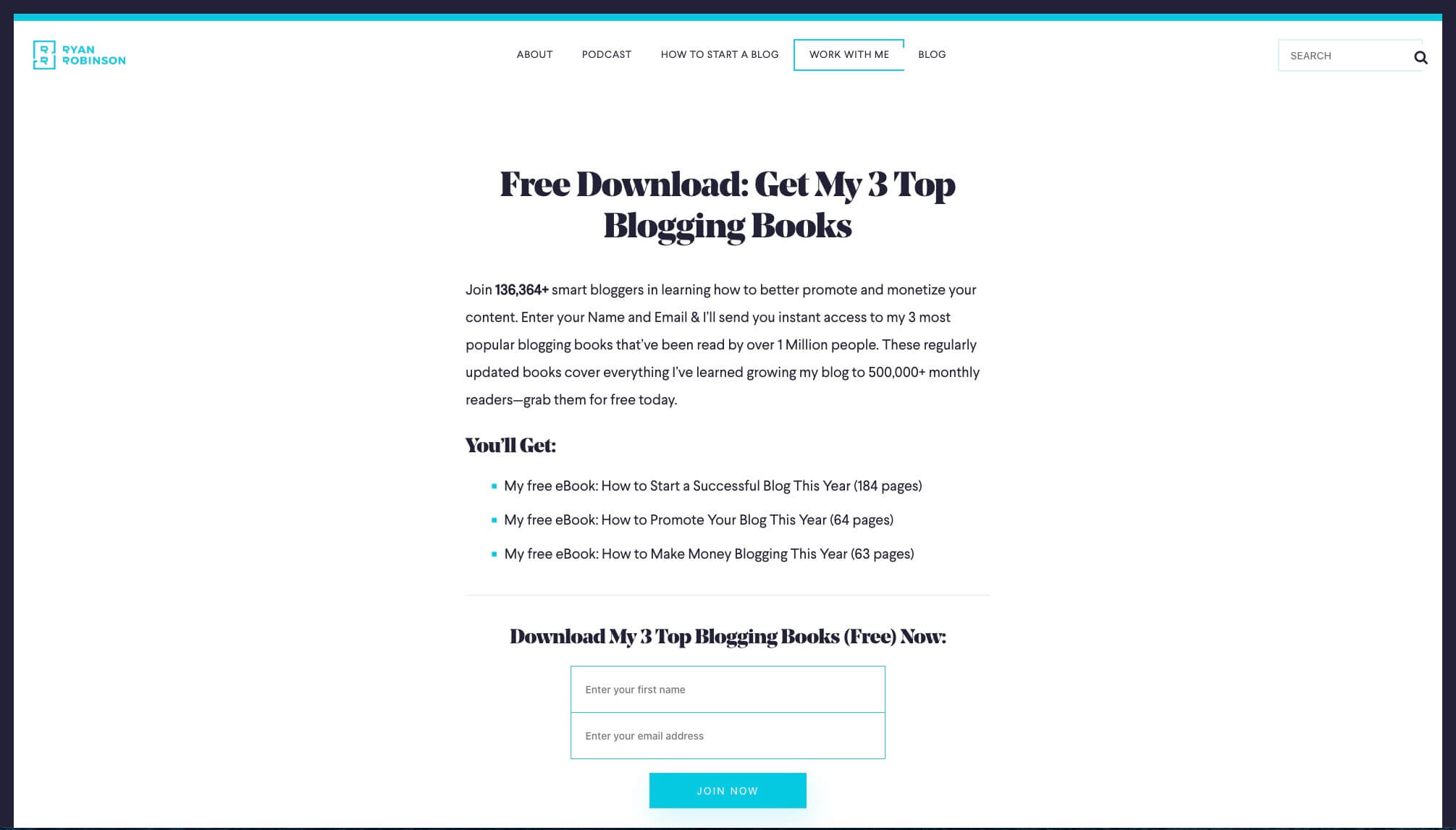
Try to make your writing precise, free of fluff and speak directly to your readers in terms they'll connect with.
Use a Compelling Call-to-Action (CTA)
Those of you who are selling your eBook, should spend some more time creating at least a somewhat longer landing page that does more selling. It also needs to include a clear CTA that asks visitors to purchase your eBook.
Here's an example of a landing page that I created for my book The Habits of Highly Successful Bloggers. This is the header image and blog headline I use to pitch this eBook to readers. It's simple and straight forward if someone is already primed to purchase my book.
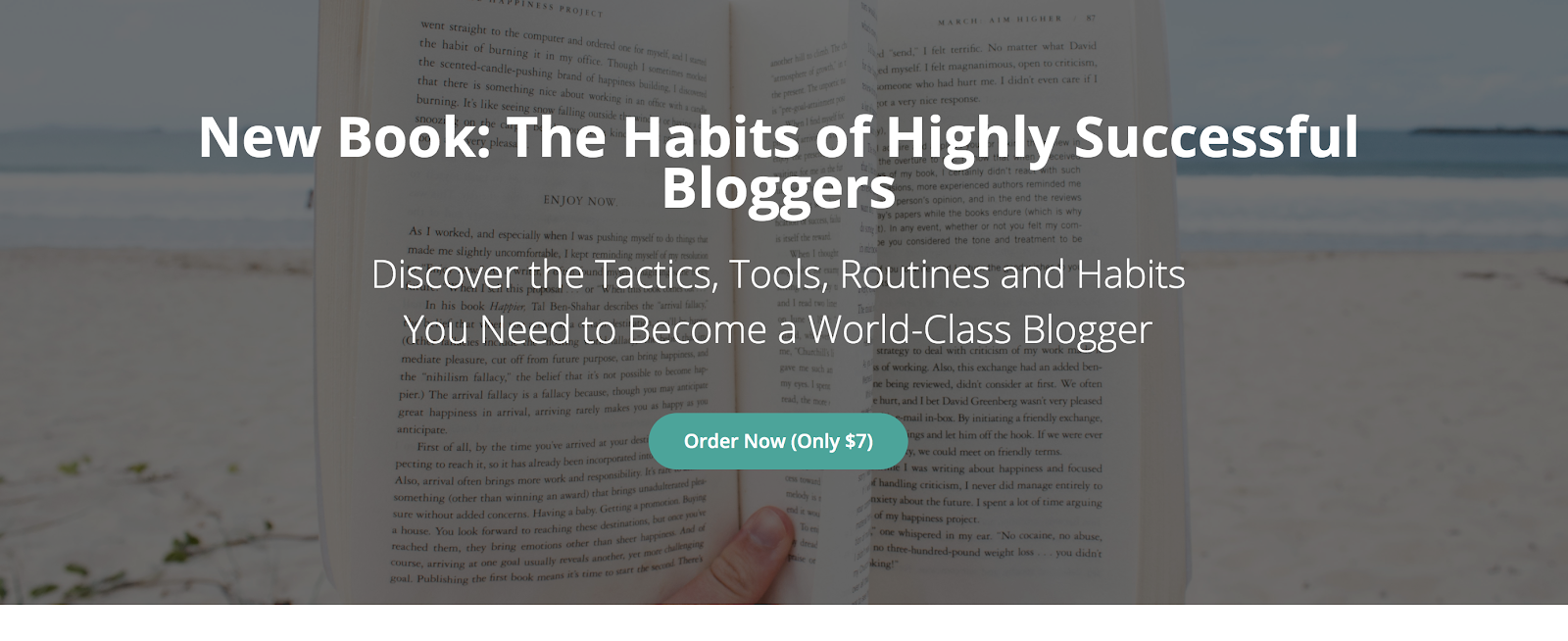
However, if this is the first time a visitor has come across my eBook (or content in general), I've also included a longer section that tells my story and explains exactly what this eBook has to offer.
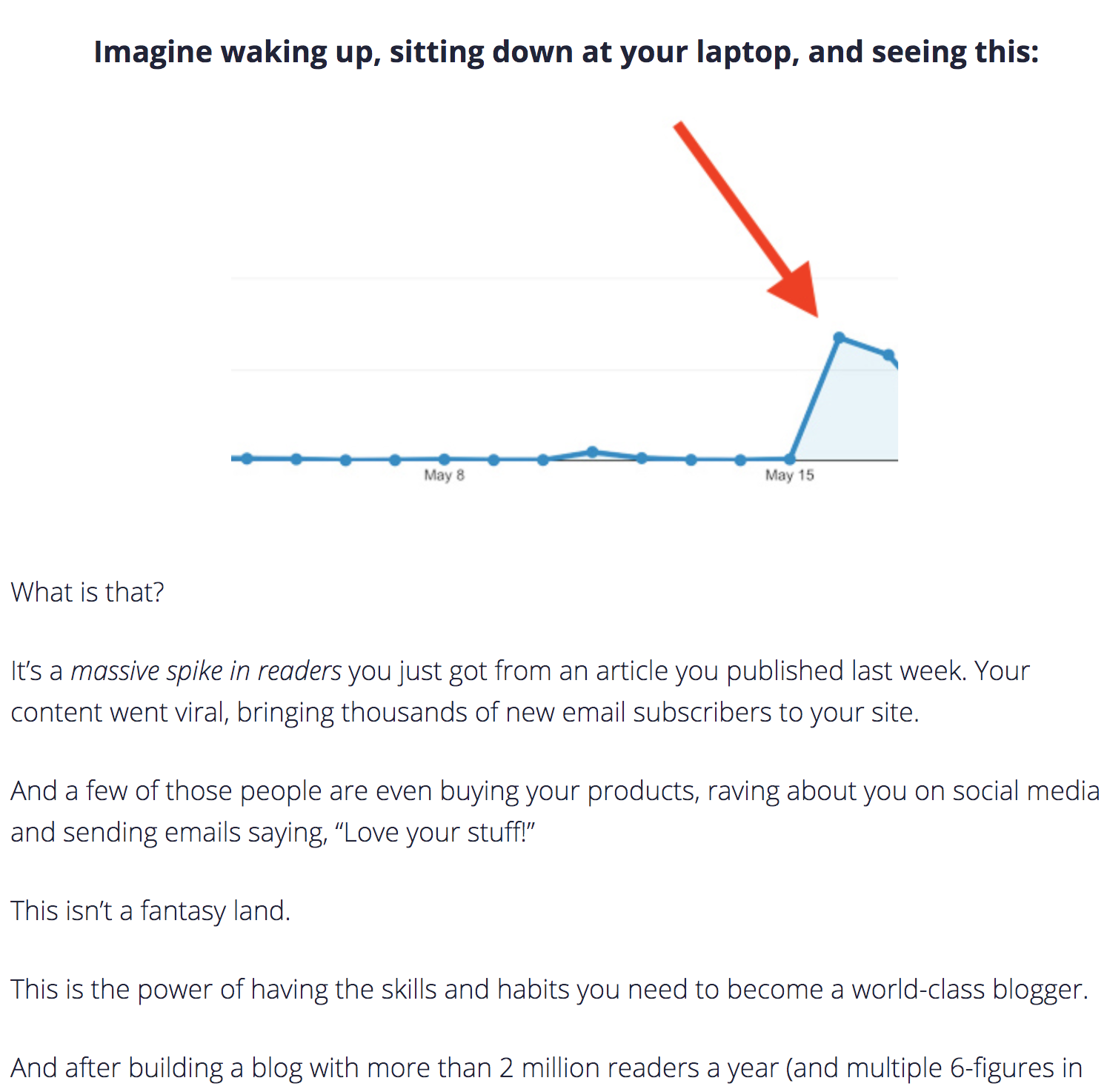
This second section of my eBook landing page shows readers what my book is all about, how it can help them in their related endeavors and the clear actionable takeaways they'll get from reading this book.
It shows them that I've been able to be successful at making money blogging—and that I'm using the lessons I've learned to help millions of readers do the same over the past several years.
Here's an example of one of my calls-to-action. After setting the stage for who I am and some of the key benefits of my eBook, I tell readers how they can purchase my eBook:
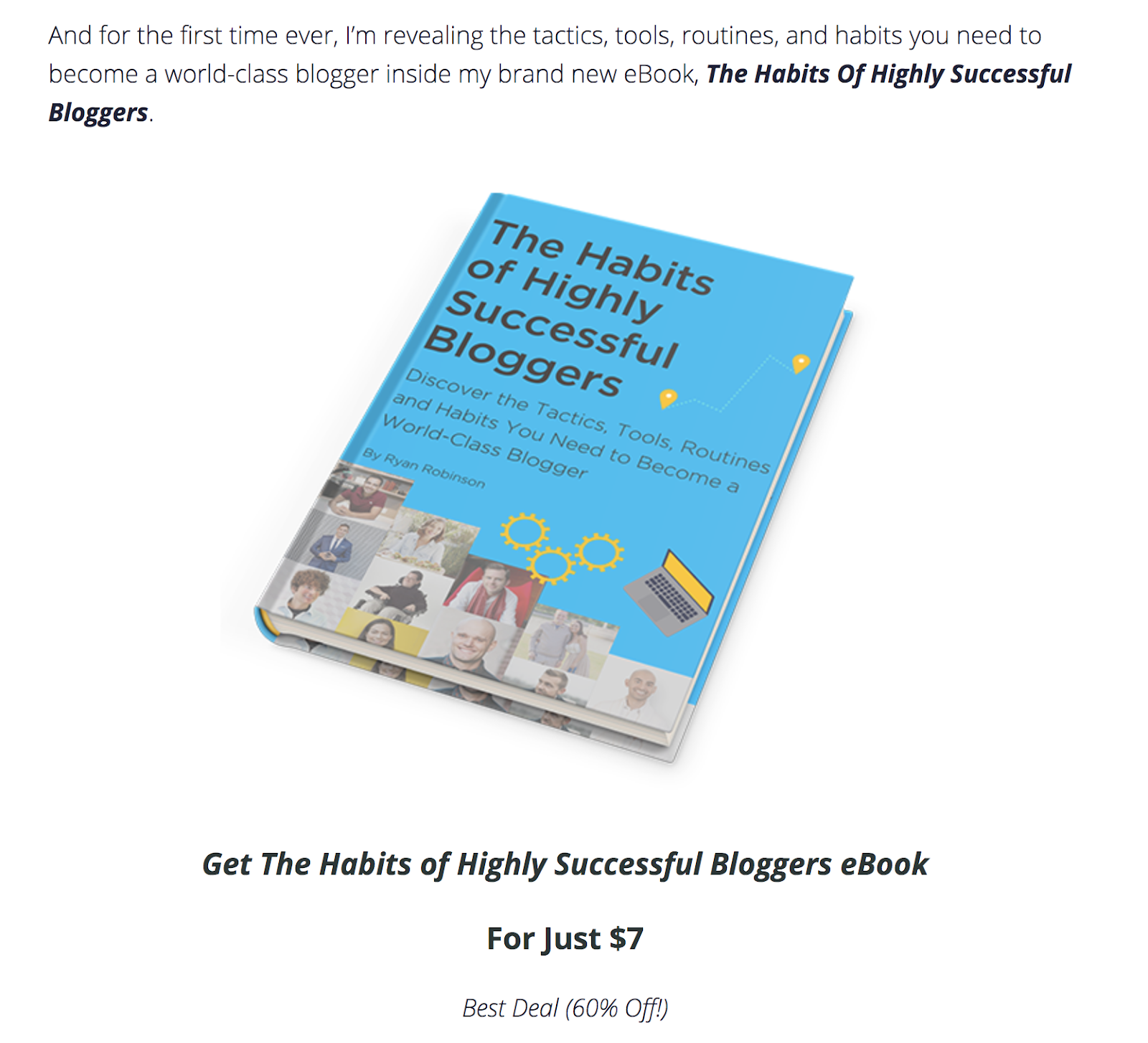
For those who aren't yet sure, or want more information, I continue on with key pain points that many bloggers experience—like wondering if they're doing things right, or struggling to find the right topics to write about. I also share more of my personal experiences and opportunities that I've had, like being able to work with Business Insider and Forbes, Inc. Magazine.
By the end of my eBook landing page, I've shown visitors two more CTAs where they have an opportunity to decide to buy. I recommend spacing these out a bit, to make it as easy as possible for people to make a purchase without feeling like you're only selling them on the page.
Use a Simple, Clean and Minimalist Layout
Choose a landing page layout that's clutter-free and easy for your readers to follow:
- Try using easy-to-scan formatting (and headers) for your descriptions
- Employ bullet points to help break up your selling points and make them easy to read
- Use stunning visuals to retain their attention and make your eBook feel premium
Now, let's look at an example. Hubspot's free eBook about How to Use Instagram for Business has a landing page that's a great example of nice, clean copy in-use:
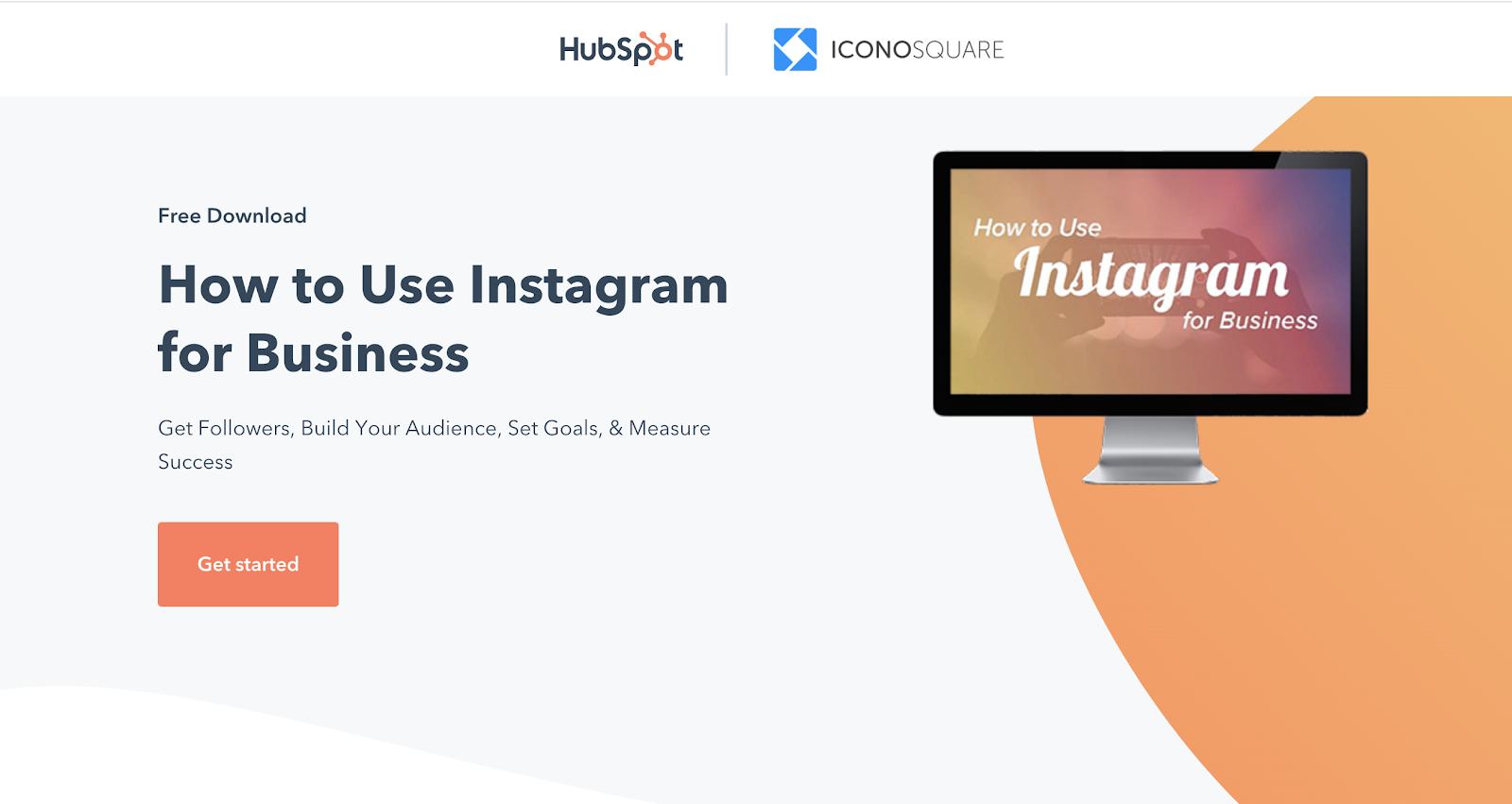
The images they use throughout the landing page are simple, but professional. They also employ negative space to draw the eye toward certain key aspects they want to highlight, and the use of checkmark bullet points is another fun example of easy-to-follow formatting.
Show People What They're Getting From Your eBook
Aside from telling people what your eBook has to offer, you can also show them. This works particularly well with image-rich eBooks that have some beautiful content to show off.
For example, Digital Photography School is a massive blog that shares actionable tips and techniques for aspiring photographers. They also sell eBooks to photographers:
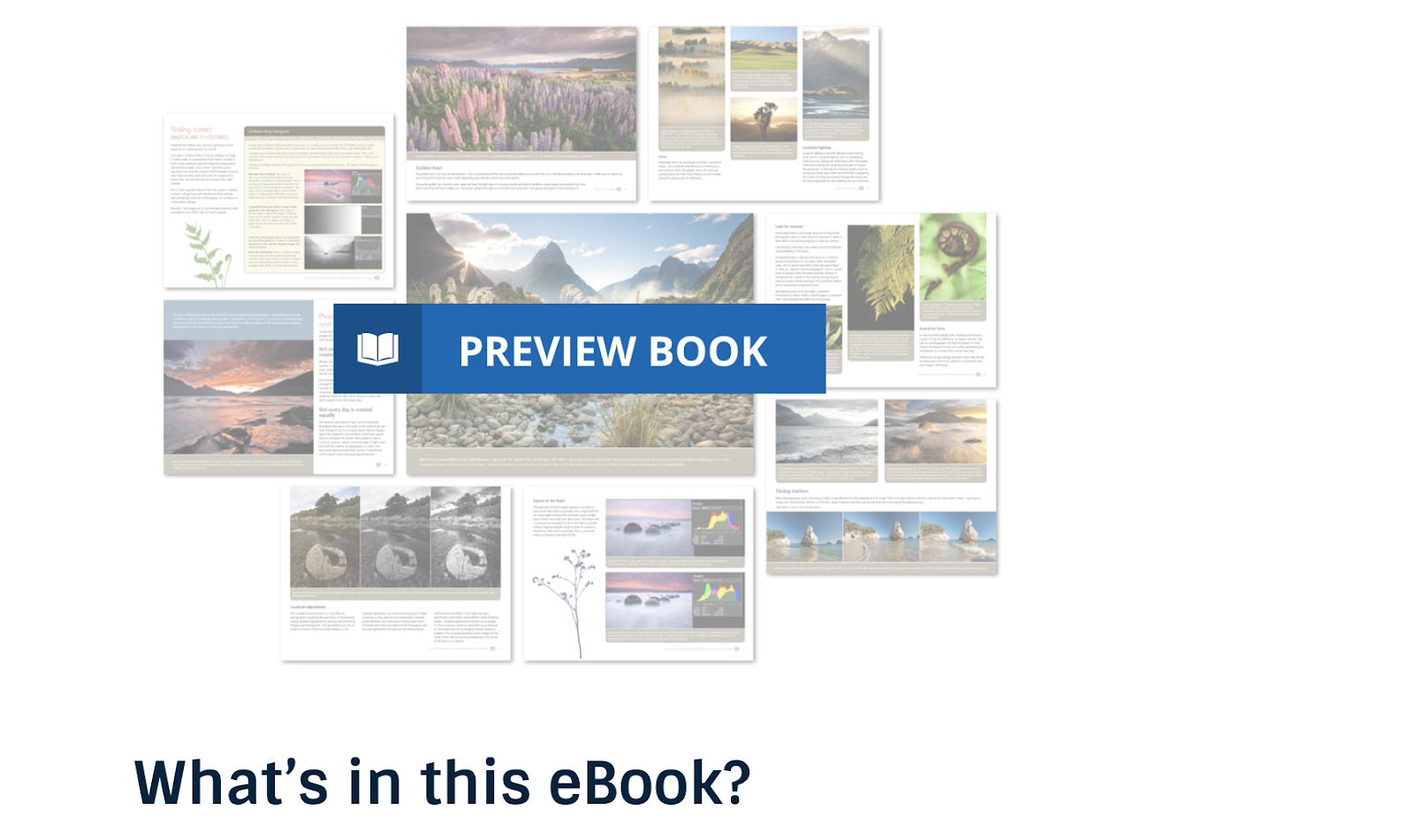
On their landing pages, they outline the key features of their eBooks, and also include a book preview section—so you can get an actual glimpse of what you're buying.
Use Email Marketing to Promote Your eBook
After crafting a great landing page, take the next step and share your eBook with your email subscribers.
Take for instance, when I launched one of my paid eBooks (the Habits of Highly Successful Bloggers) to my email list a couple of years ago:

That one email alone led to more than 350 sales of my eBook on the day I finished writing it.
Your email list is a group of people that are already most connected to your writing and what you have to offer them. They're the primary group of people who'd be most likely to spend a little bit to gain access to your new eBook content (if it resonates with them and their needs).
Want to take it a step further? My advice is instead of waiting for your eBook to be finished, strive to create some interest on your email list before it launches. Use anticipation to create anticipation of an eBook you're currently writing. Then, when your eBook finally publishes, your audience is already familiar with the topic—and excited to see if it's right for them.
Use a Compelling CTA (to Promote Your eBook) Across Your Blog
Another way to promote your eBook, is to place clear calls-to-action asking readers to purchase (or download) the eBook on various key pages around your blog. Here's an example:
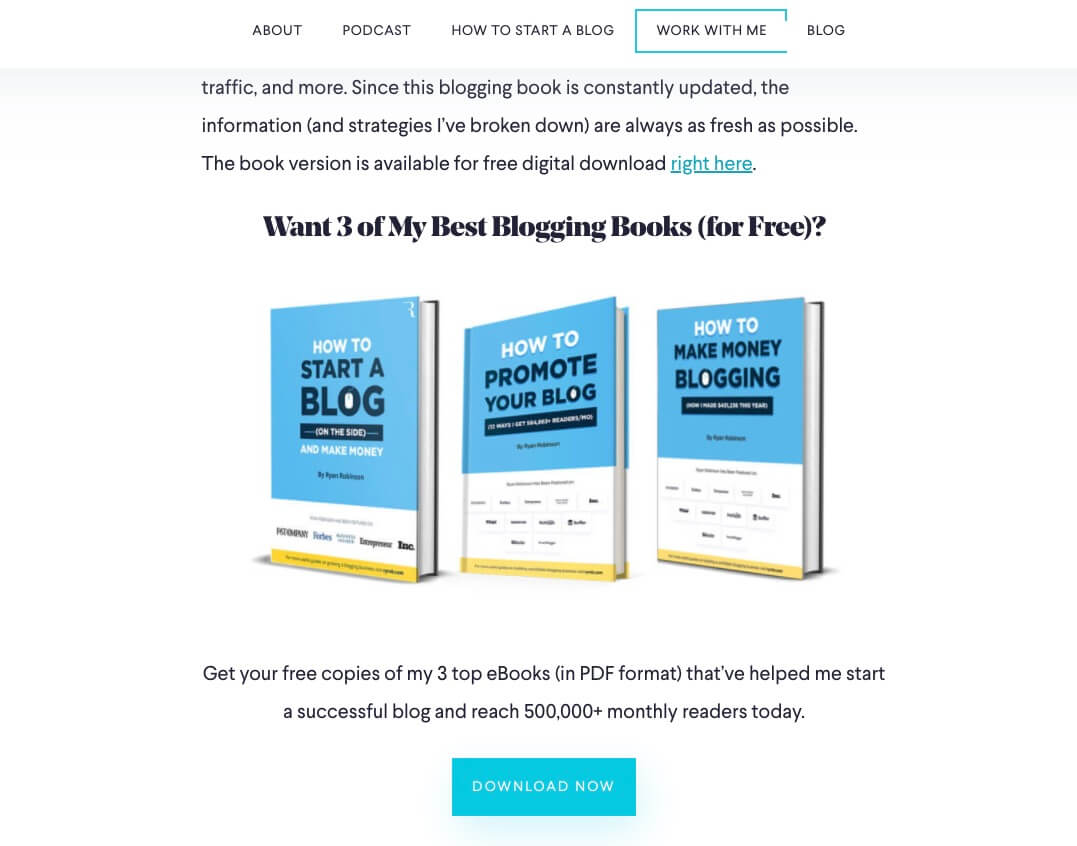
You can do this in a number of ways by using:
- Popups
- Headers
- Footers
- Sidebars
- Manually inserting CTA text (or images) within your blog posts
These are all locations that you can either link to your eBook's landing page—or even place a direct buy button if the content topics are directly relevant. My advice is to direct readers to your landing page if they'll want to learn more about your eBook before making a purchase, though.
If you're using a free eBook to generate leads for another monetization channel like selling a blogging course, you can send those new subscribers a direct download link straight to their email address once they subscribe and confirm.
Promote Your eBook on Social Media
The right social media channel can be an excellent destination to both build excitement and drive eBook sales.
During the writing phase of your eBook, you can post teasers letting people know what you're up to (if you have an engaged following, group or community you interact with).
For example, The Prairie Homestead is a blog dedicated to relearning the art of homesteading. With a focus on growing vegetables and cooking from scratch, it made sense when blogger Jill Winger decided to write her own recipe book. Here's an Instagram post she shared (back in 2018) to generate some excitement for her upcoming book:
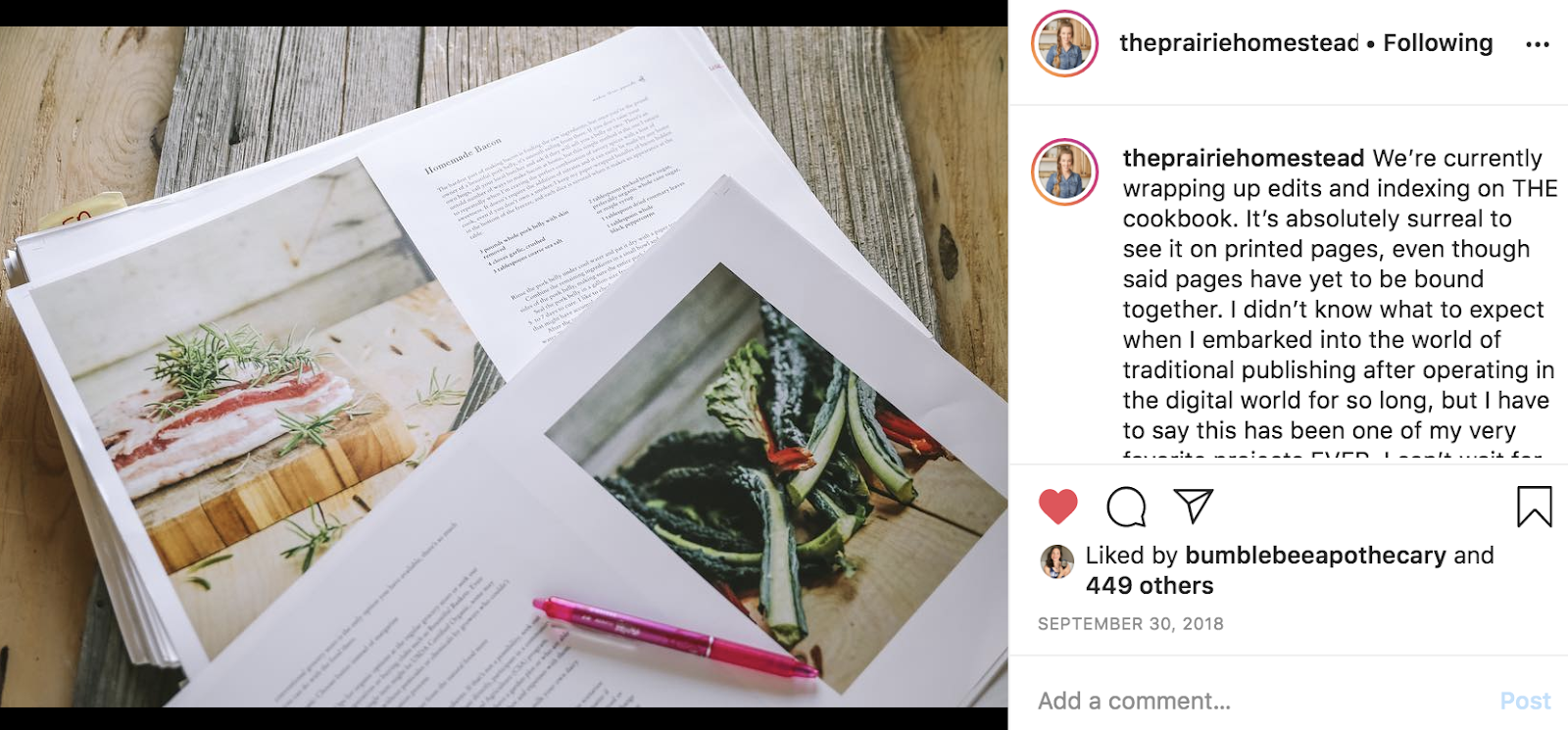
Even before she finally launched her book, she was building the anticipation and sharing her enthusiasm, while growing it in her audience at the same time.
While she technically didn't write an eBook, and instead created a book for physical distribution, the same exact technique can be applied to promoting your eBook, too.
If you want a (very) detailed guide about generating more interest for your eBook, check out my ultimate guide about how to promote your blog—which dives much deeper into the topic of bringing in readers to consume (and purchase) your content.
7. Expand Your Reach by Selling Your eBook on Amazon
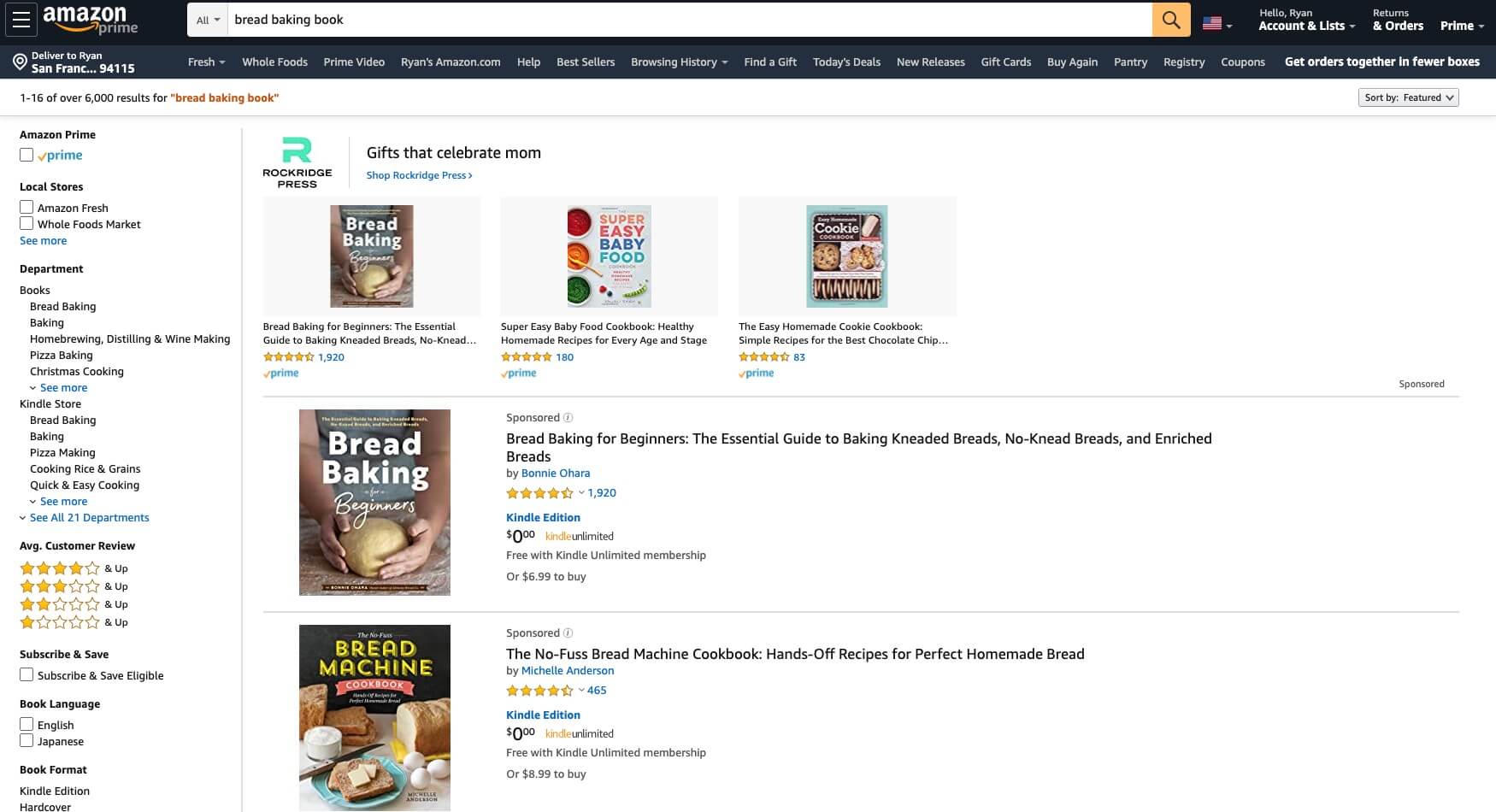
Selling your eBook through your blog audience is the first avenue that I recommend to most bloggers. You can keep all of the profits, you have complete control over how your eBook is displayed and distributed, plus you get to retain all of the contact information on your customers (as well as adding them to your email list for further marketing efforts).
After you've set your eBook up on your blog though, you may find that you also want to sell it on Amazon. The big appeal for Amazon, is the incredibly large audience that you can reach through their platform—if your book is well-positioned to succeed.
Amazon has over 200 million prime users, and in the fourth quarter of 2021, it's expecting net sales of between $130 and 140 billion dollars. There's no denying that Amazon is a juggernaut when it comes to converting sales and is certainly an entity that can lead to an avalanche of sales for your eBook.
My advice? Take a mixed approach of promoting your eBook through your own blog, and after your initial push, work on setting up a listing on Amazon as a secondary source of potential new customers.
So how do you go about selling your eBook on Amazon? It's not too difficult, but it's a multi-step process.
Let's run through the steps here, so you can easily upload your eBook to Amazon and (hopefully) generate some extra sales.
Set up a Kindle Direct Publishing (KDP) Account
Before you can sell your eBook on Amazon, you first have to set up a Kindle Direct Publishing (KDP) account.
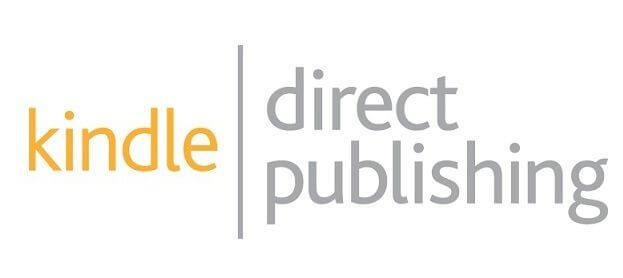
To do this, head over to the KDP homepage and register your Amazon account. If you already have an Amazon account, you can use your existing login information to sign up for KDP and link your account.
During registration, you'll be asked to enter the author's name, payment preferences and relevant tax information (so that Amazon can eventually pay you out as an author on their platform).
Choose a Clever Title and Catchy Subtitle
When you're ready to publish your eBook on Amazon, you'll naturally be asked to write your eBook's title (which if you've followed this guide, you'll have already done a great job with). Let's examine the listing for Flour Water Salt Yeast: The Fundamentals of Artisan Bread and Pizza [A Cookbook], because it's a pretty great example:
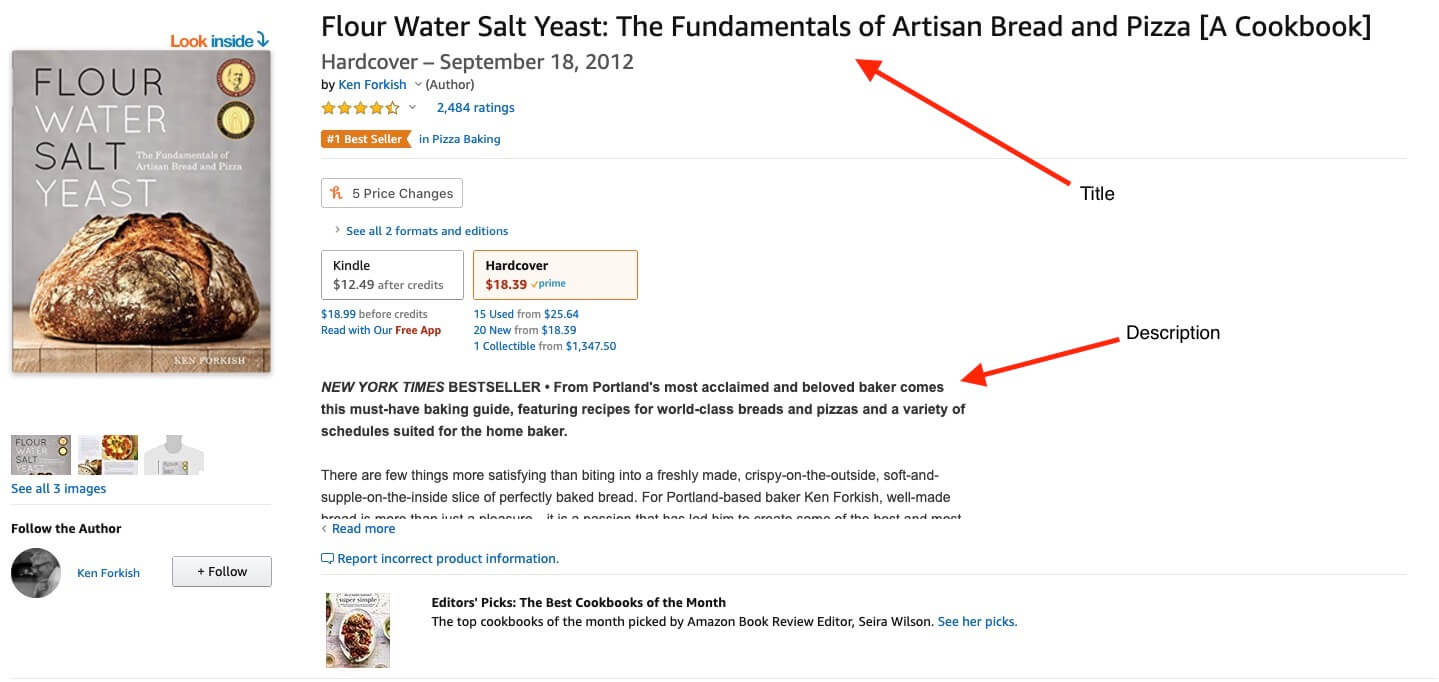
You can also choose to put in a subtitle, which is a great spot to further sell readers on why they should purchase your eBook—and give yourself a better chance at including important keyword phrases that'll definitely help your eBook appear in more Amazon search results.
Write a Great Amazon eBook Description
People come to your Amazon listing to decide if they want to purchase your eBook.
Aside from choosing an enticing title and a well-designed eBook cover, they'll also look to your book description to decide if it's something they want to spend their hard-earned money on. Your eBook description should be relatively concise, yet written like a sales page that highlights what makes your eBook exceptional.
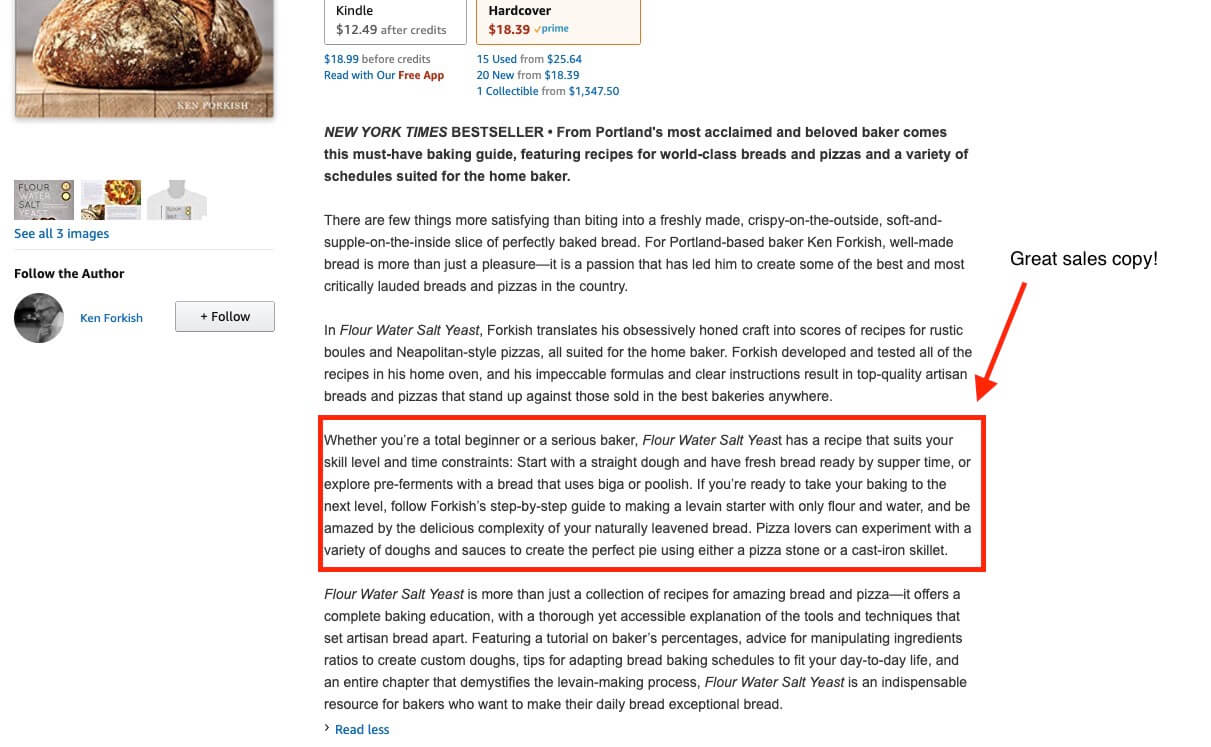
It should also clearly outline what they'll get from reading your eBook—and why you're the person they should be listening to (purchasing from).
Another important thing for bloggers in particular to do in the description of your Amazon eBooks, is to include a link back to your blog. This is a real opportunity to promote your blog and drive traffic back to your blog. Even if a reader doesn't purchase your eBook from the Amazon listing, you may be able to convince them to join your email list or purchase something else from your blog.
Choose Keywords for Your eBook
When choosing keywords to describe your eBook, you should take into consideration both Amazon and Google searches. For example, here's a keyword map that provides recommendations for surfacing your book in the Romance category of books on Amazon:
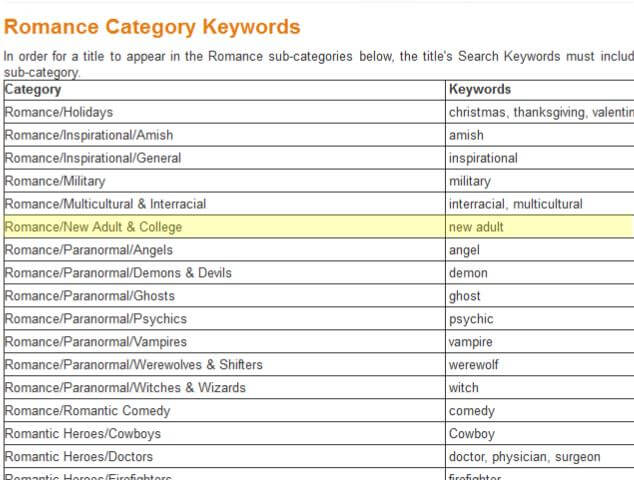
Know that customers will search on both Google and Amazon for the type of books they're seeking, and you have the chance to rank for both.
Amazon has a few recommendations for choosing the best keywords to use for describing your eBook. Some of the advice they share include:
- Combine words in the most logical order (think about the way people might search for something and use that in your keyword description
- You can use up to seven keywords or short keyword phrases
- Keywords can be changed or updated in the future
- Do some research on Amazon by typing in the keywords you're thinking of and see if they yield similar results to your eBook (if not, try something different)
- Avoid using keywords that are already used in the book's metadata
Select Your Amazon eBook Category
Keywords help people find your eBook, but so does selecting the appropriate category for it in the first place.
Amazon allows you to select both categories and subcategories.
The key is to pick categories that truly reflect what your eBook is about (and ideally ones that already have clear demand). Choosing categories simply because they're popular though, will not lead to greater sales—because people will be frustrated when your book comes up as a recommendation if it doesn't match their search intent.
Instead, pick trending categories that truly relate to what you've spent so much time learning how to write an eBook about. If possible, try to pick categories that also appear to have low competition. Doing this will help you rise to the top in Amazon searches for more niche topics that have higher purchase intent—and can increase your odds of ranking higher in your broader category pages too.
Upload Your Manuscript to Amazon
The next step is to upload the manuscript of your eBook, so it can be repackaged and (soon) distributed as a Kindle book.
Amazon says that your book must be formatted properly and meet their quality standards (which includes the appropriate KPF file format that we covered above).
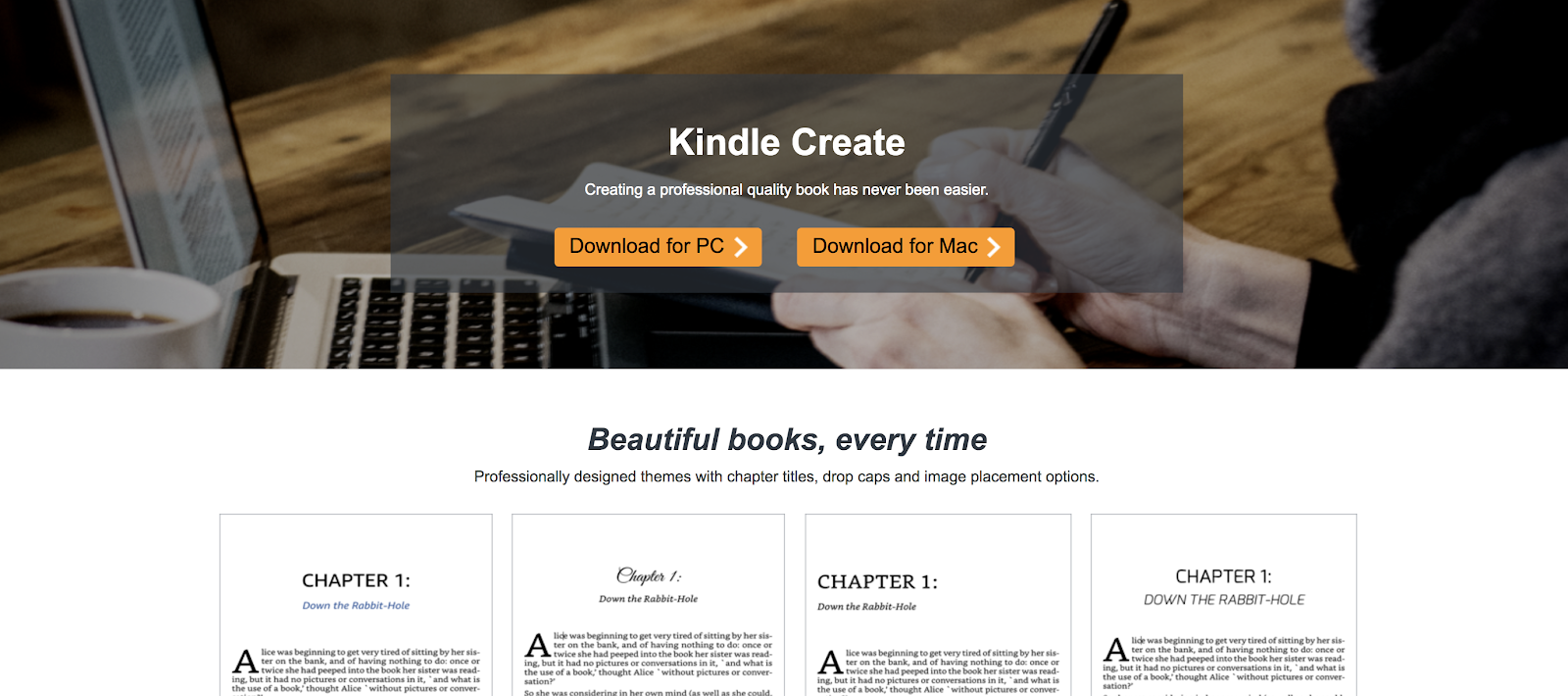
Amazon suggests uploading a KPF file made with "Kindle Create" for the best results when uploading, or otherwise a Microsoft Word DOC/DOCX file.
Upload eBook Cover Art
Your Cover Art is the next thing that you'll need to upload.
If you haven't already created the cover art for your eBook, you can use the Cover Creator tool in KDP to design one—or turn to one of the design tools I mentioned above.
Price Your Amazon eBook
Setting a price for your eBook is always a matter of debate, but there are some things you can to do maximize profits on Amazon in particular.
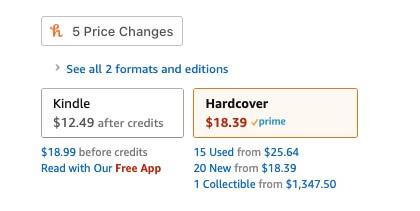
Recently, Amazon rolled out KDP pricing support, which provides a lot of helpful information to guide you in making an educated decision about how to price your book on their platform. This program analyzes data for books that are similar to yours and recommends a price. This program is still in its beta as of right now, so keep in mind it's a recommendation—not a requirement.
One funny thing to understand about revenue earned on Amazon is that you have to choose between two royalty rates you actually get paid out on. There's a 35% royalty rate and a 70% royalty rate option to choose from (weird, I know).
- If you select the 70% royalty rate, you'll keep 70% of the profits from your eBook, while Amazon keeps 30% (ideal)
- If you use the 35% royalty rate, Amazon will keep 65% percent (less ideal)
Naturally, you want to make as much as possible, so the 70% rate sounds like the best choice. However, Amazon's pricing system is fairly complicated and there are quite a few regulations guiding how you can price your books. Not every eBook is eligible for the 70% royalty rate, and not every country is, either.
For example, to use the 70% royalty rate—your eBook has to be priced between $2.99 and $9.99. It also has to be priced at least 20% lower than a print version of your book (if you have one).
Amazon lists their requirements and information about the different royalty plans, so you can choose the best option for your eBook.
Publish Your eBook on Amazon (and Start Promoting)
After submitting all the information about your eBook, the final step is to save your progress and hit submit on the publishing process.
When you submit your eBook, it takes Amazon 24-48 hours to approve your work. They'll send you an email when your eBook is approved and will provide you with a direct link to your listing too.
From there, it's a smart idea to take some of the promotion strategies we've talked about here and apply them to the Amazon version of your eBook too—because if the Amazon platform can detect that you're driving traffic to your listing from external sources, then it'll be much more likely to surface your eBook higher up in category pages too.
How to Write an eBook in 2022: Final Takeaways and Advice
Are you feeling excited by the challenge of learning how to write an eBook this year… or is it a little overwhelming?

The goal here isn't to psyche you out of this potentially lucrative monetization channel, but rather to provide an actionable framework for learning how to write an eBook (and selling it) over the course of the coming weeks, months and years.
Better yet, let's frame writing an eBook as an exciting opportunity to take your blog to the next level—by driving traffic from new sources (like Amazon) and eventually increasing your revenue.
Here's some even more promising news: If your first eBook isn't as successful as you're hoping, you can always learn from the experience and perform better on your next attempt. Just as the very first blog post you write probably isn't your best work ever, the same is true with writing your first eBook. Practice and repetition are the name of the game.
As you develop the skills necessary for learning how to write an eBook, each new eBook you produce can be an improvement upon the last—and it can even lead to eventually writing a traditional book
With time, you can also go back to earlier editions of your eBooks and update them with new information, better formatting and fresh designs.
Have you already written an eBook of your own?
If so, share with us. I'd love to hear about it in the comments below!
How To Sell An Ebook On Your Blog
Source: https://www.ryrob.com/how-to-write-an-ebook/
Posted by: mooretaks1965.blogspot.com

0 Response to "How To Sell An Ebook On Your Blog"
Post a Comment